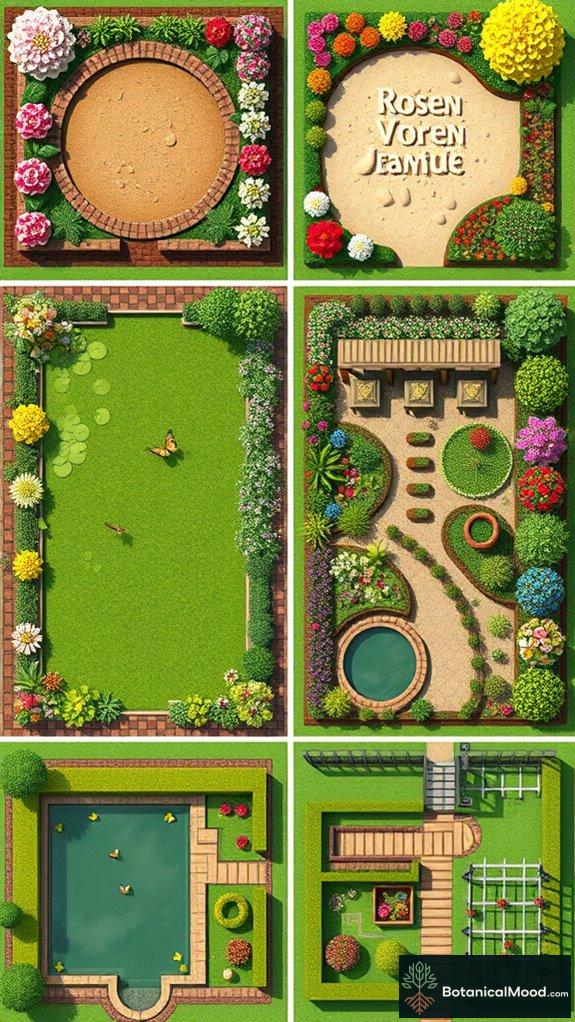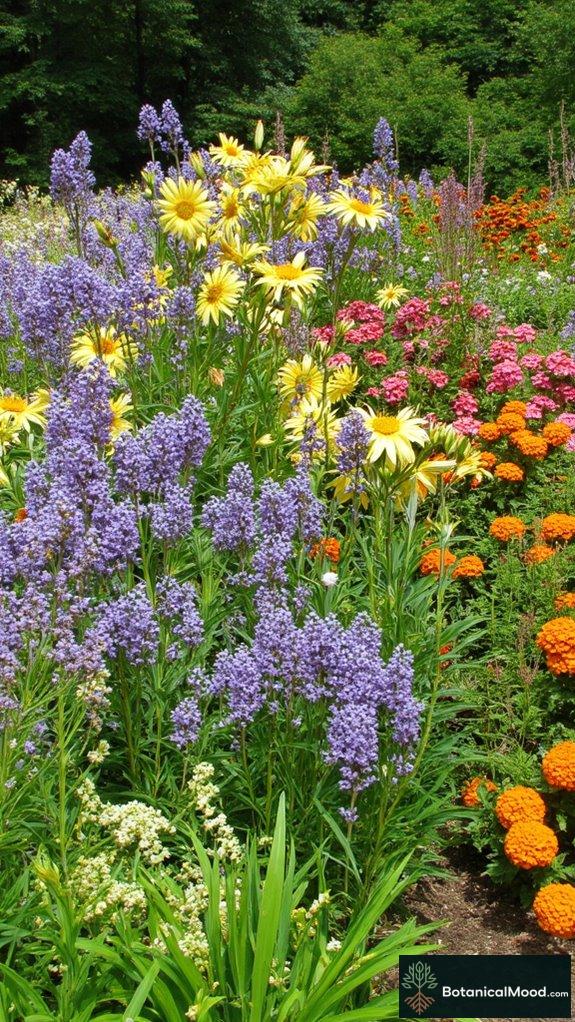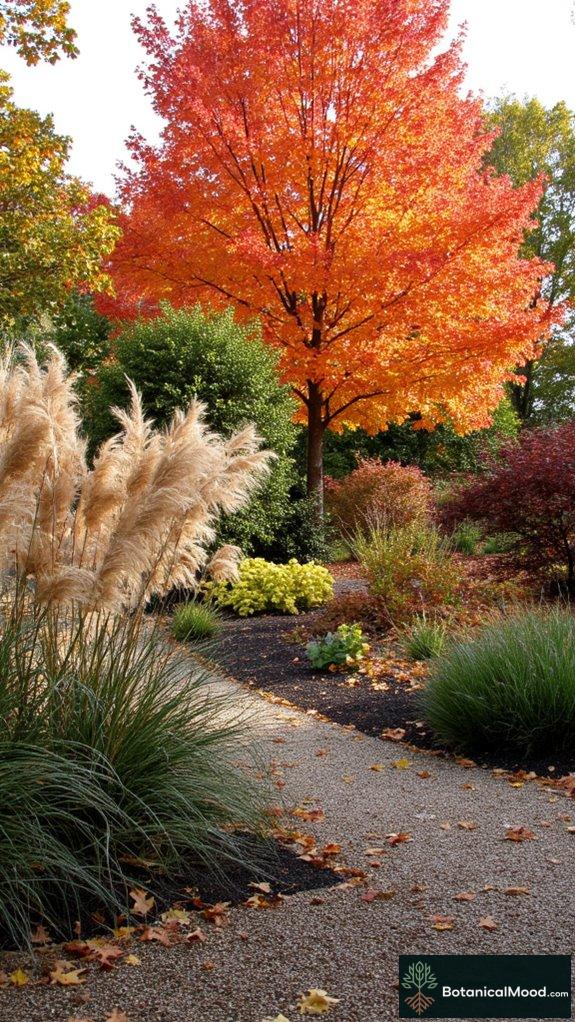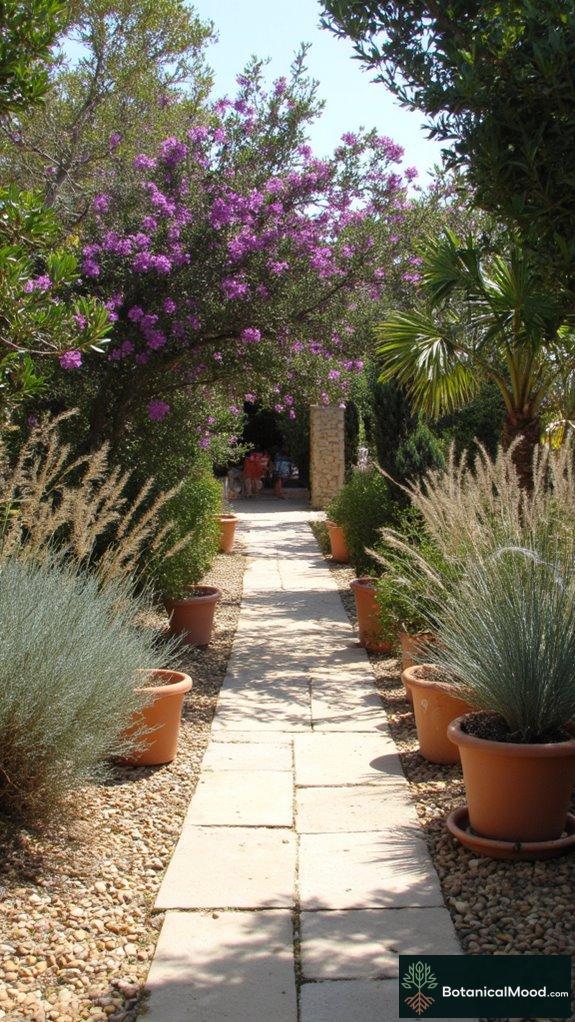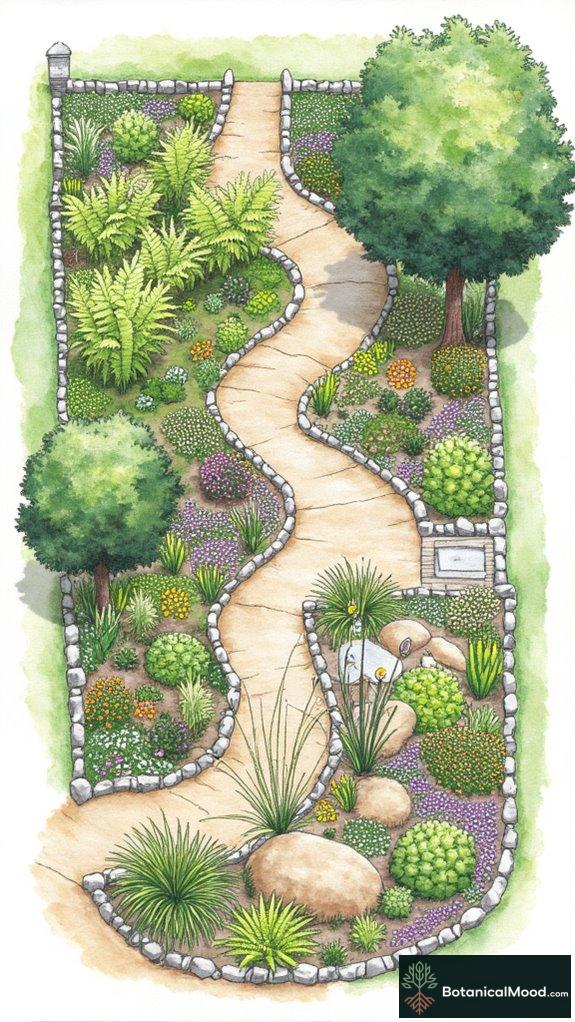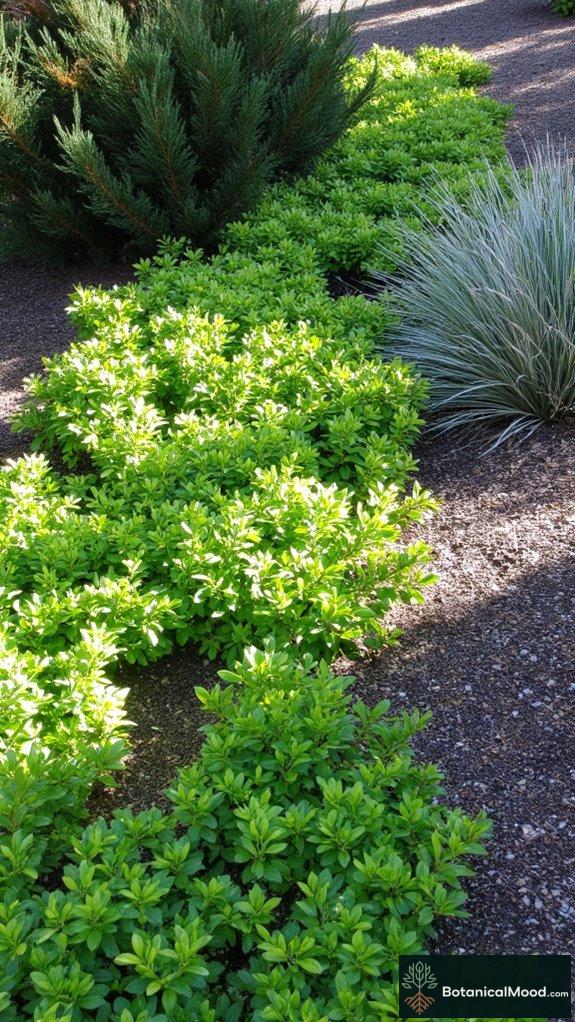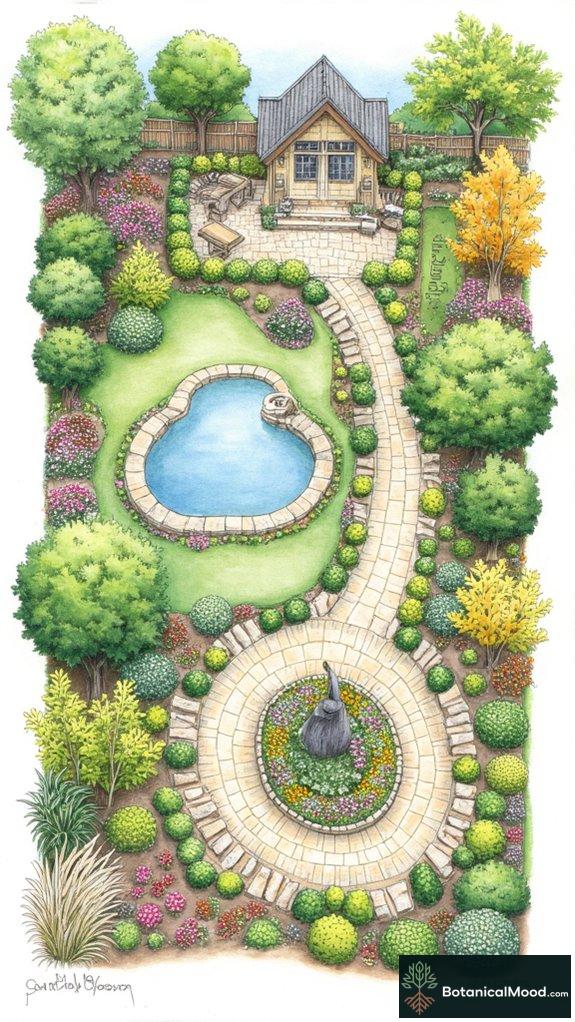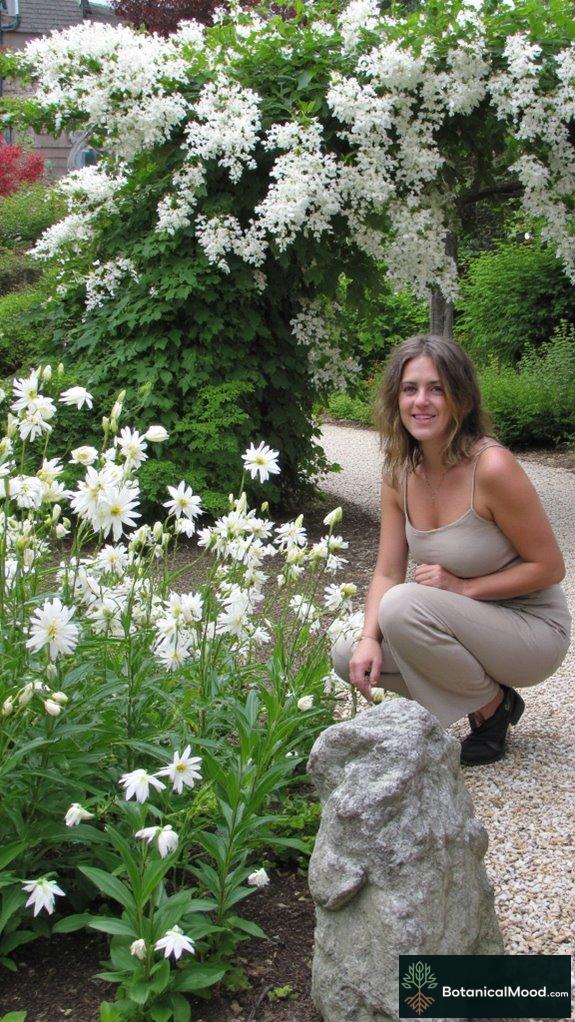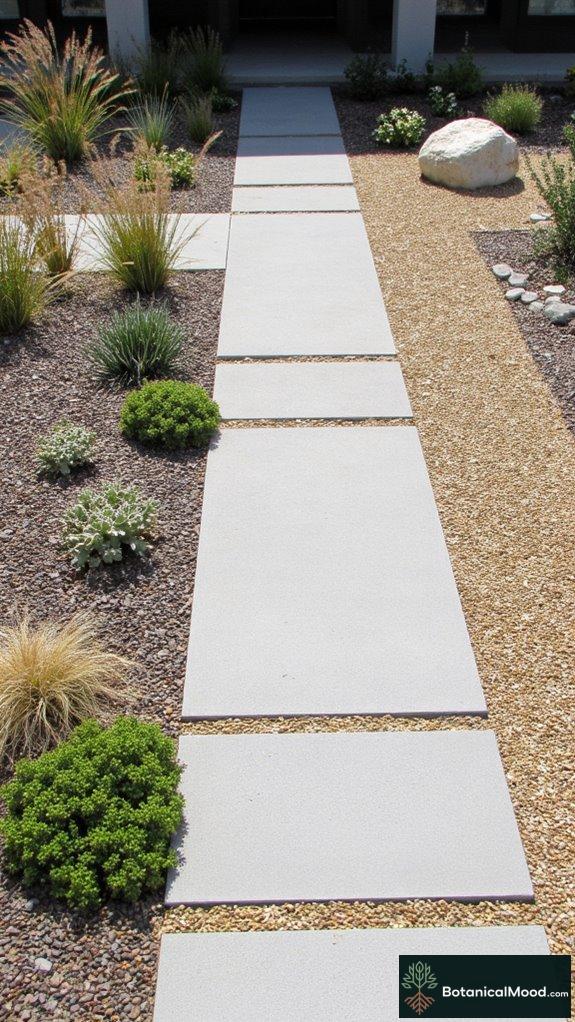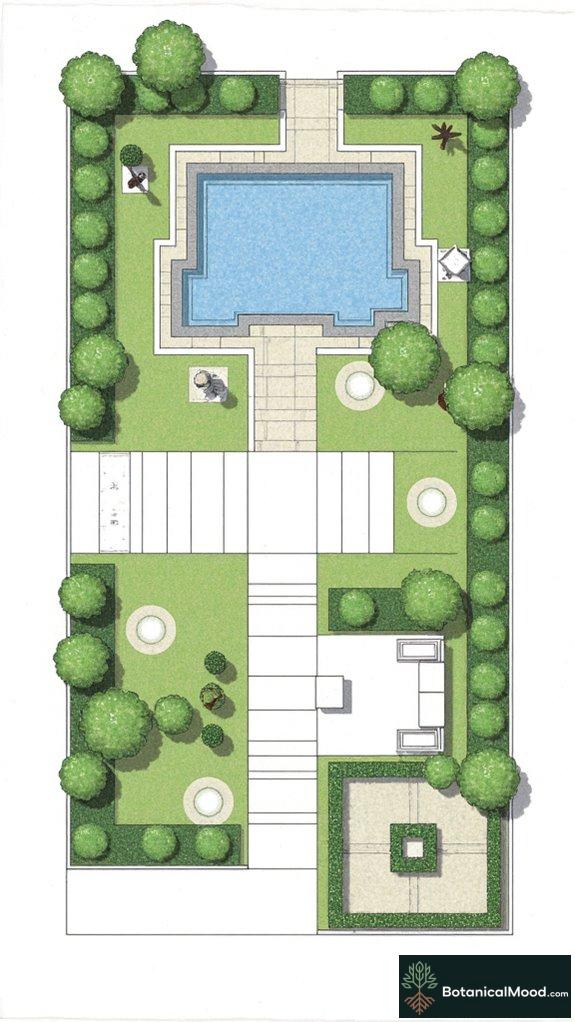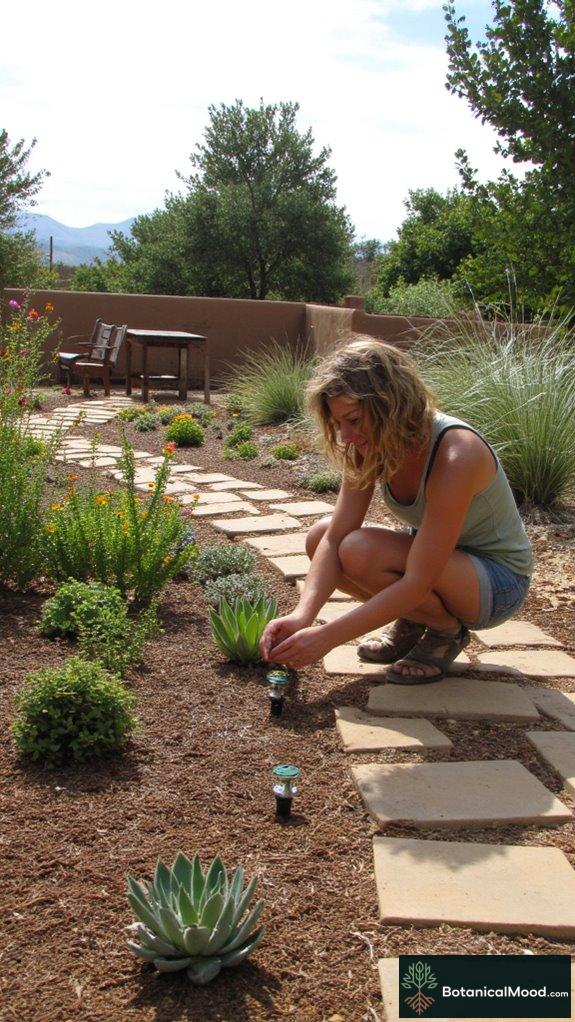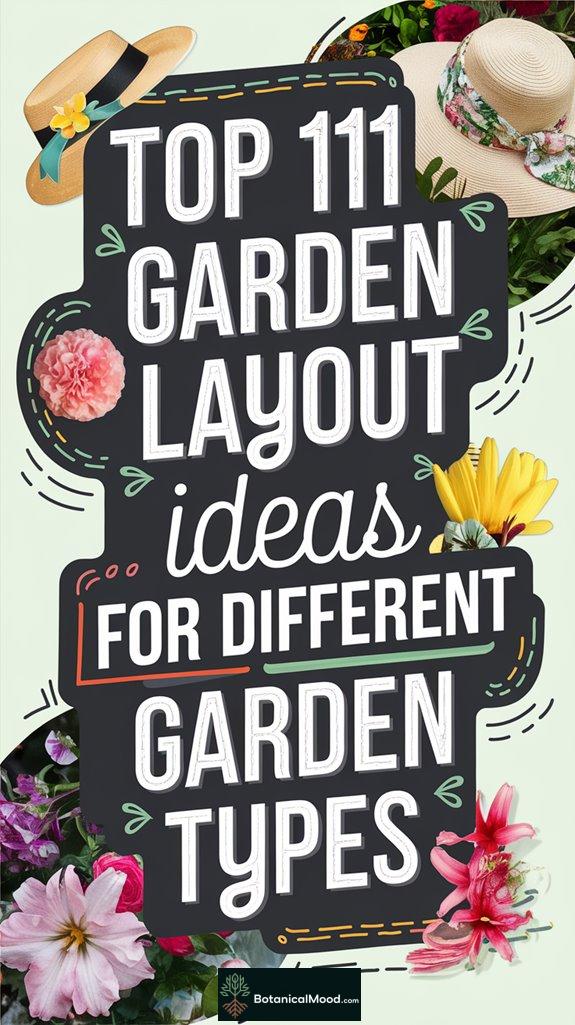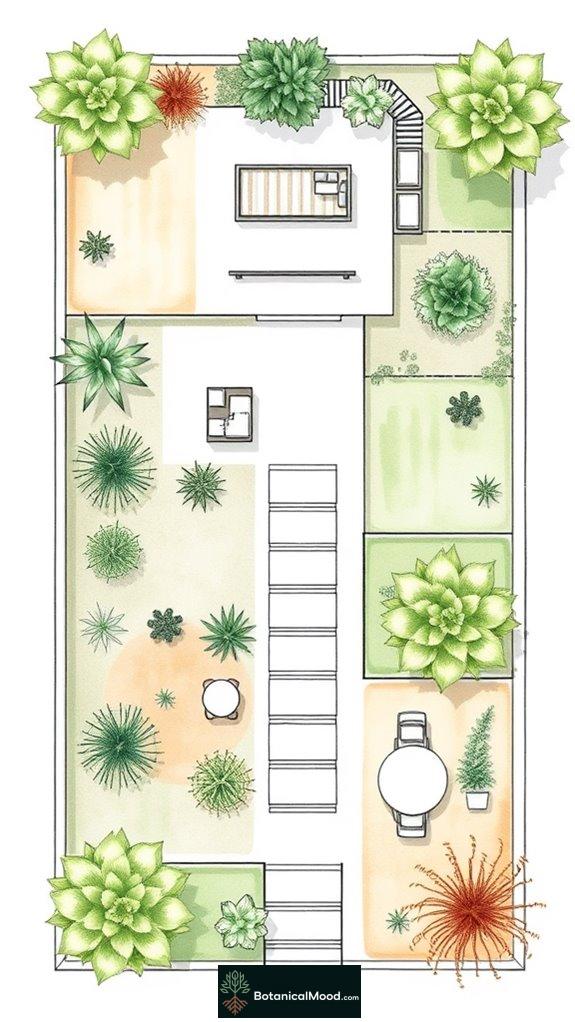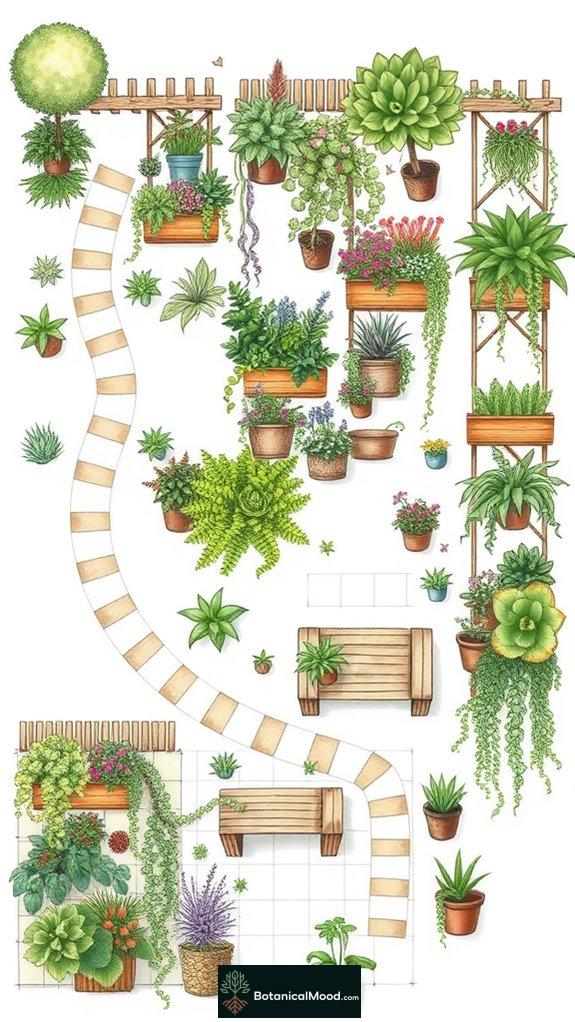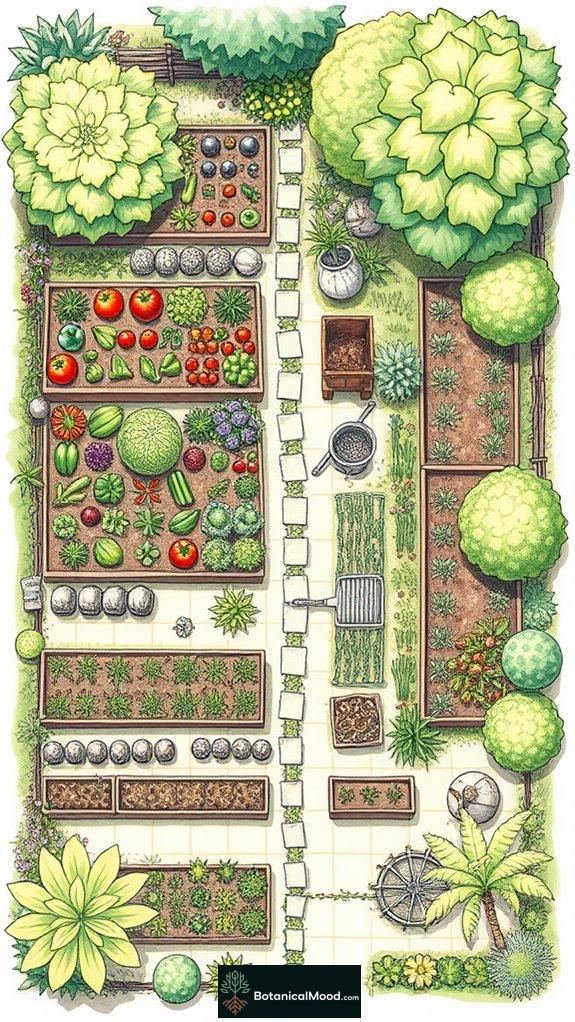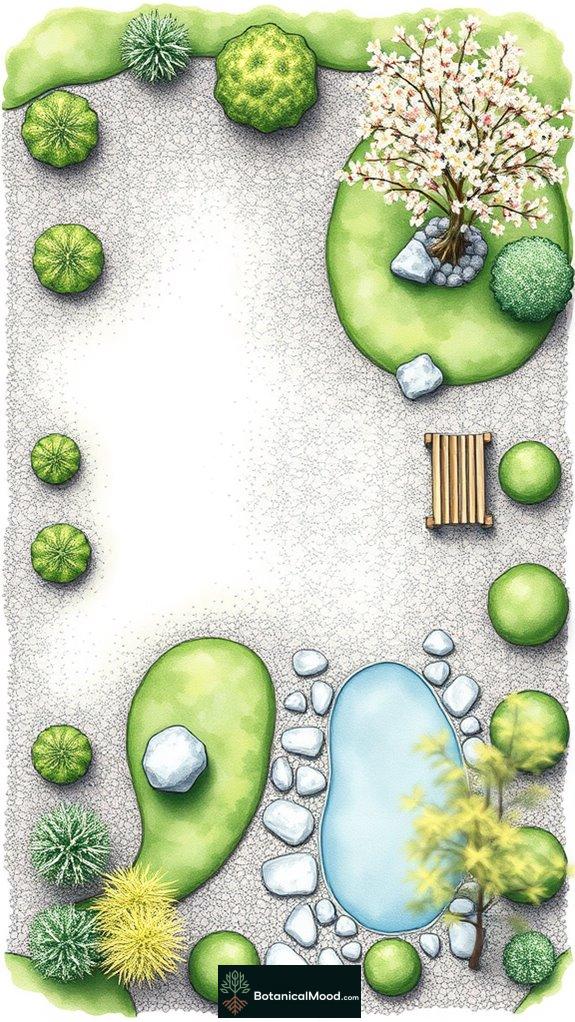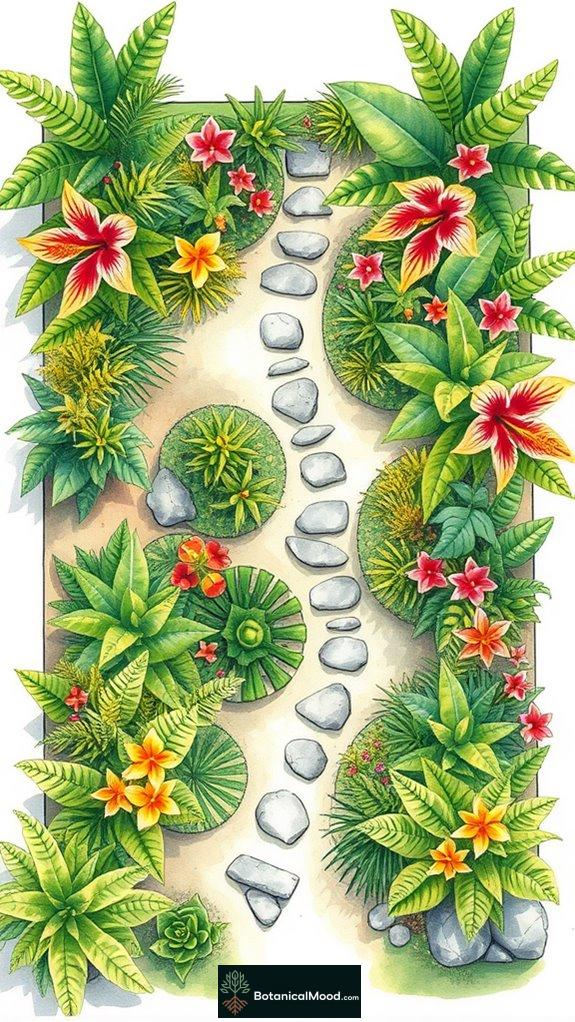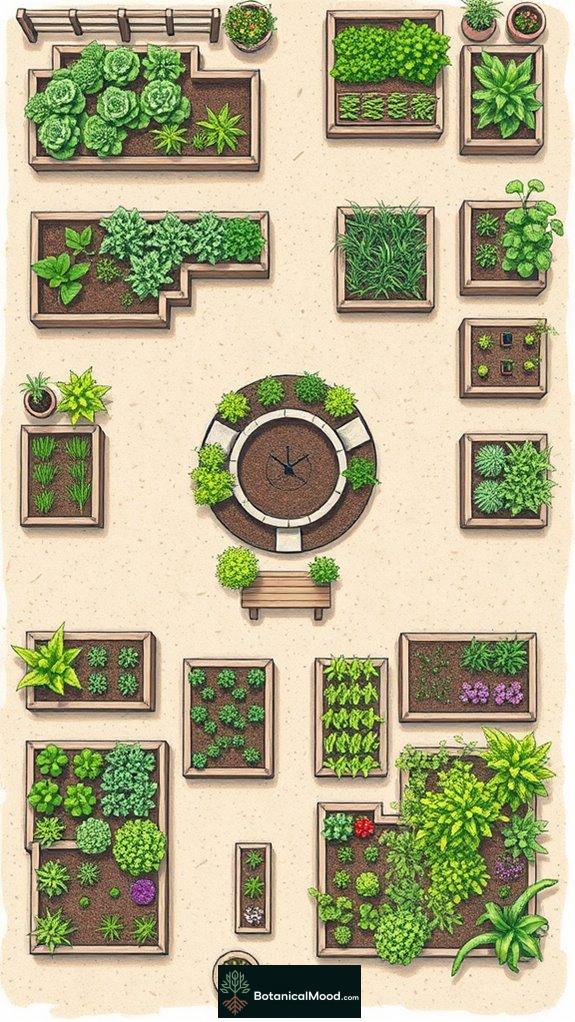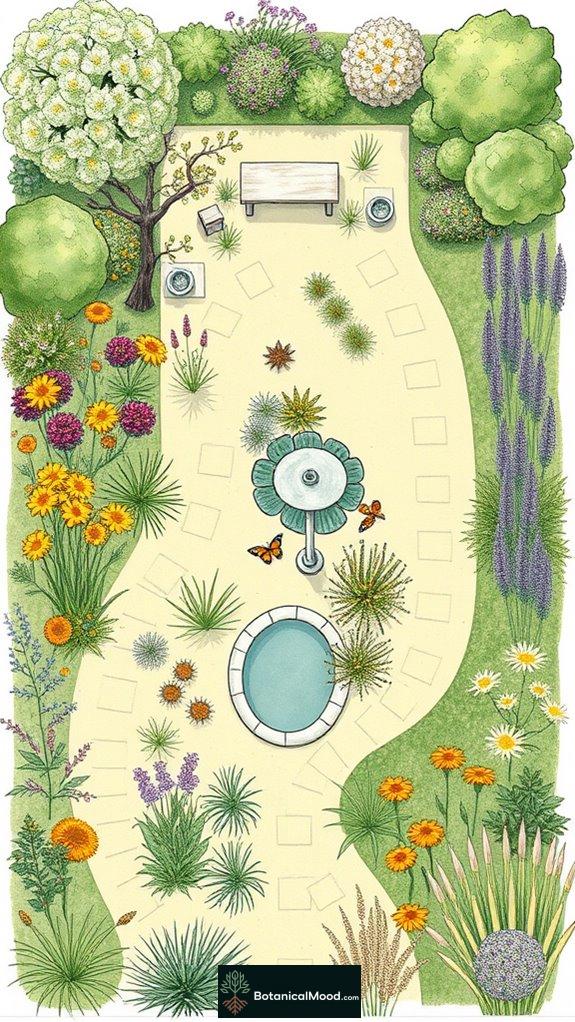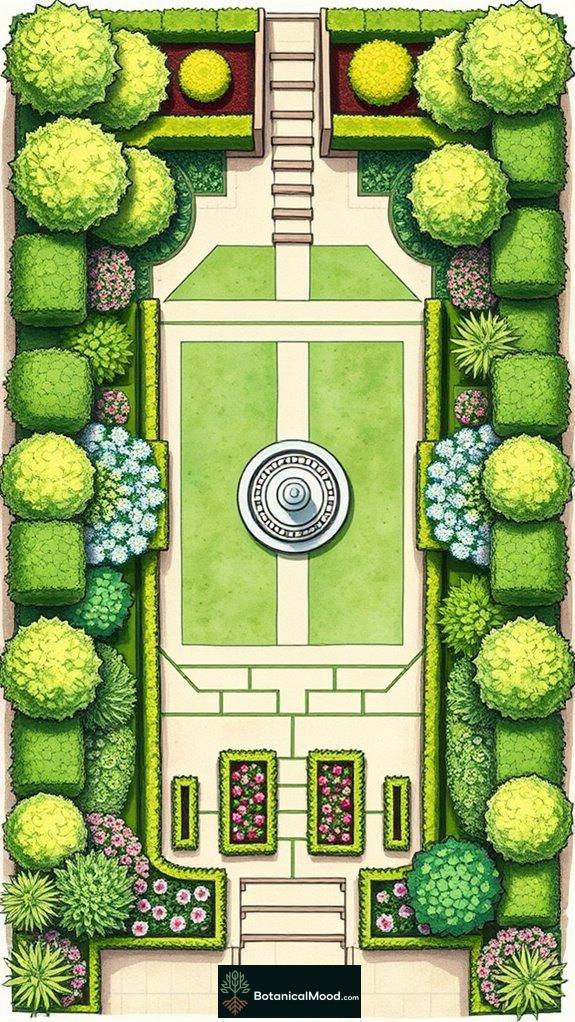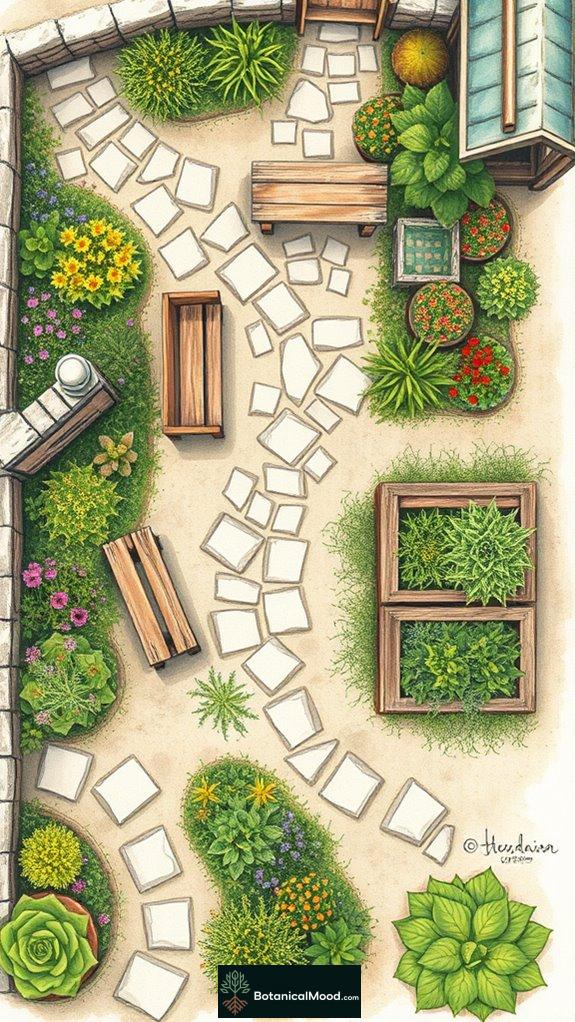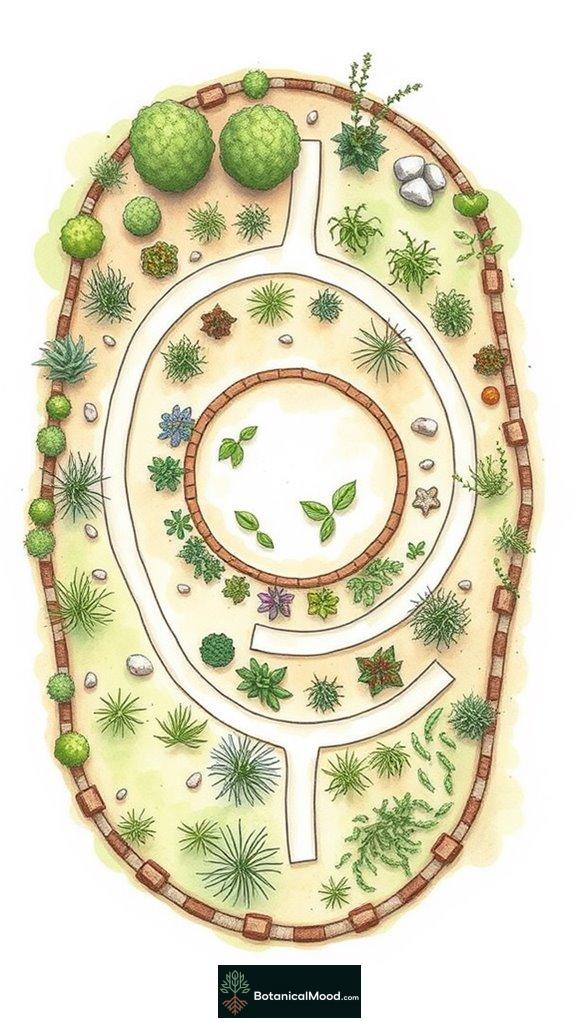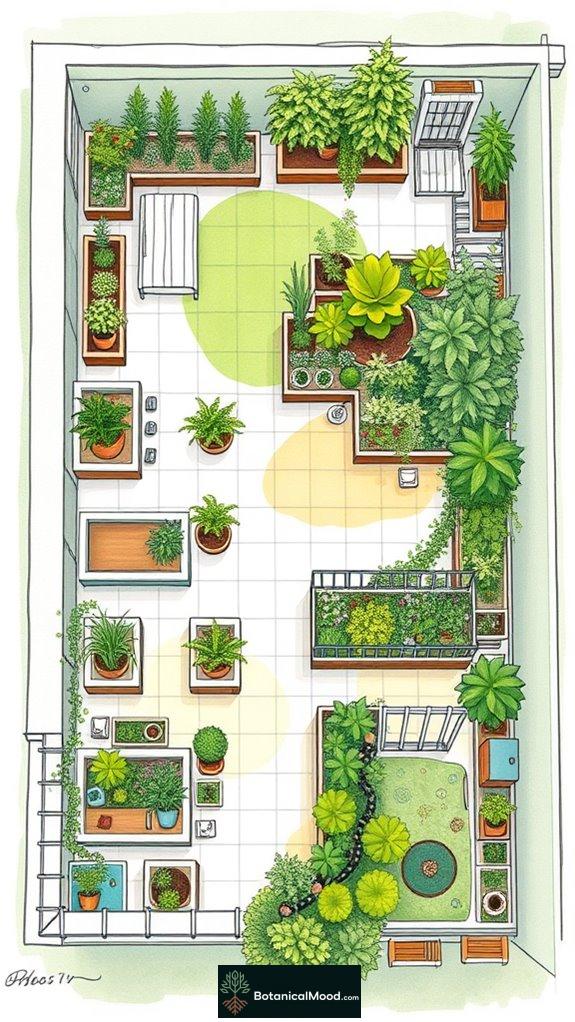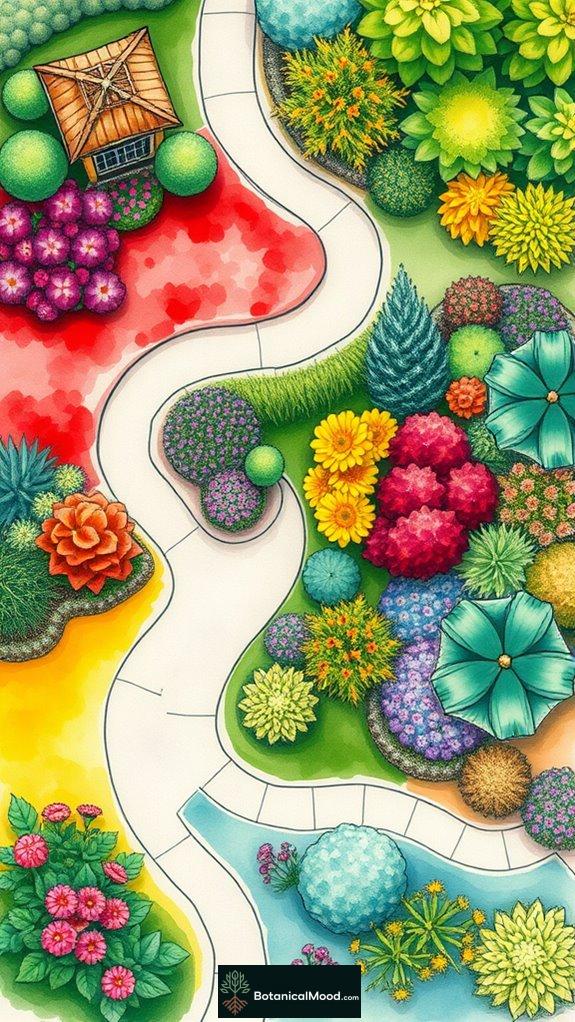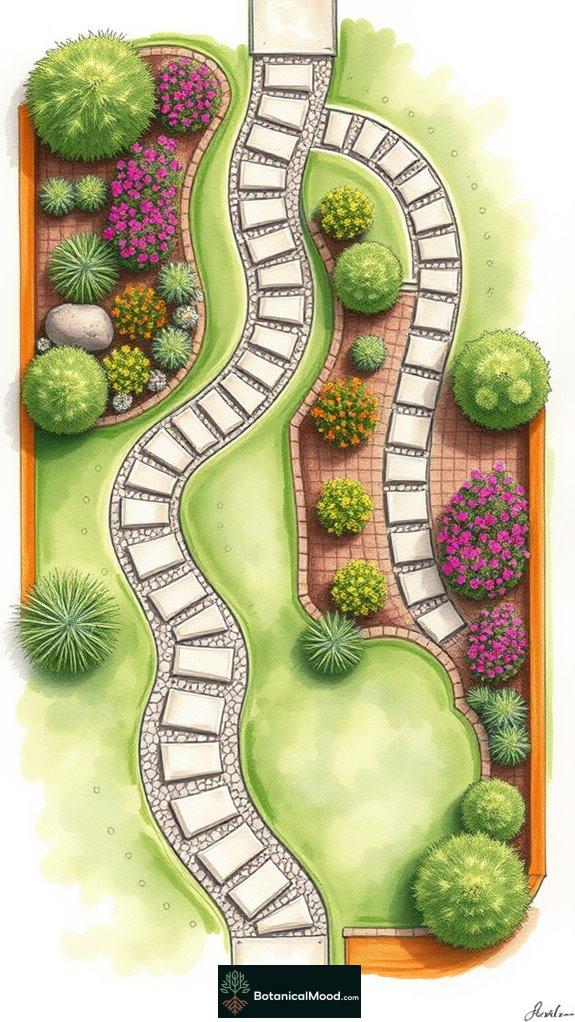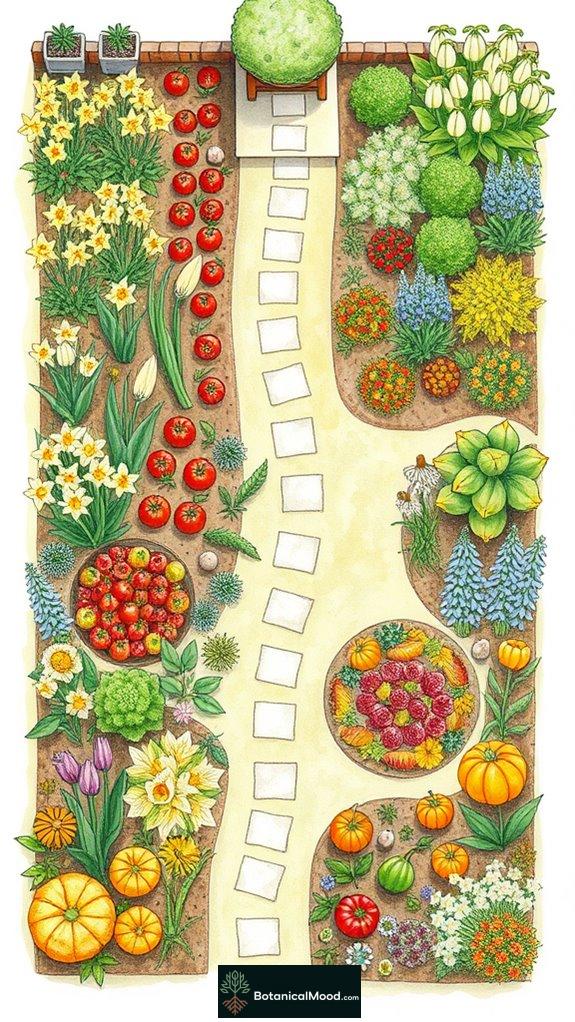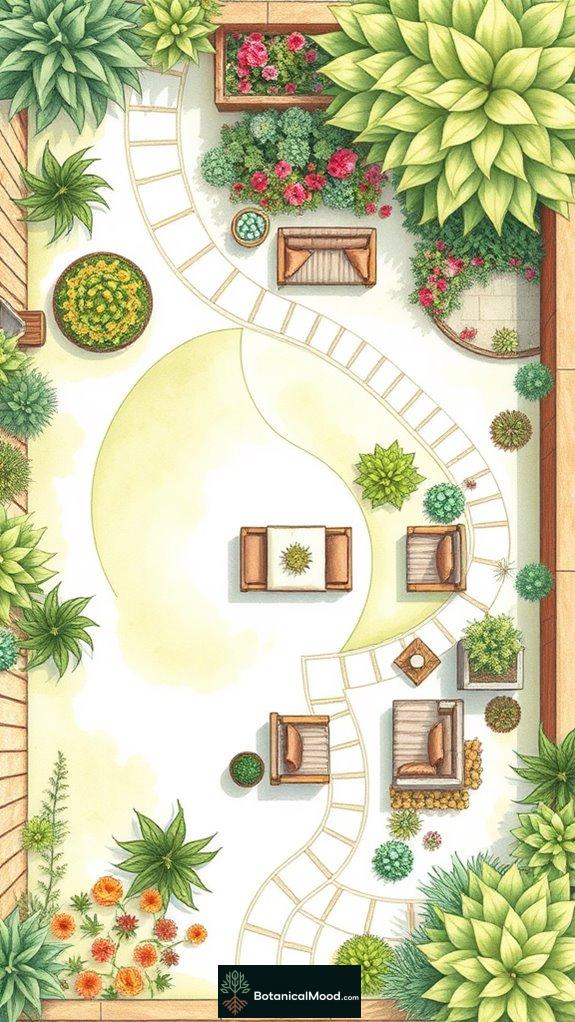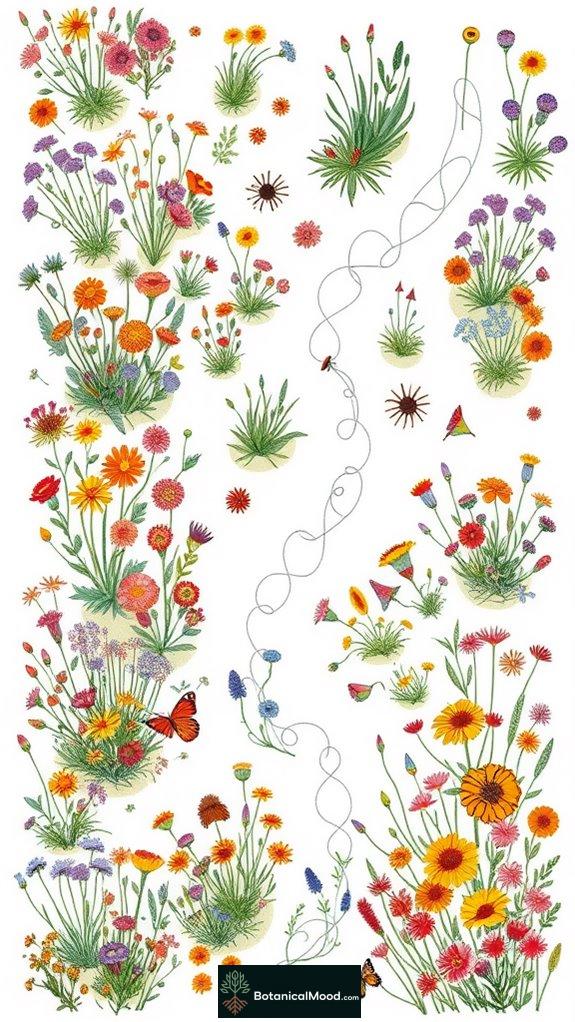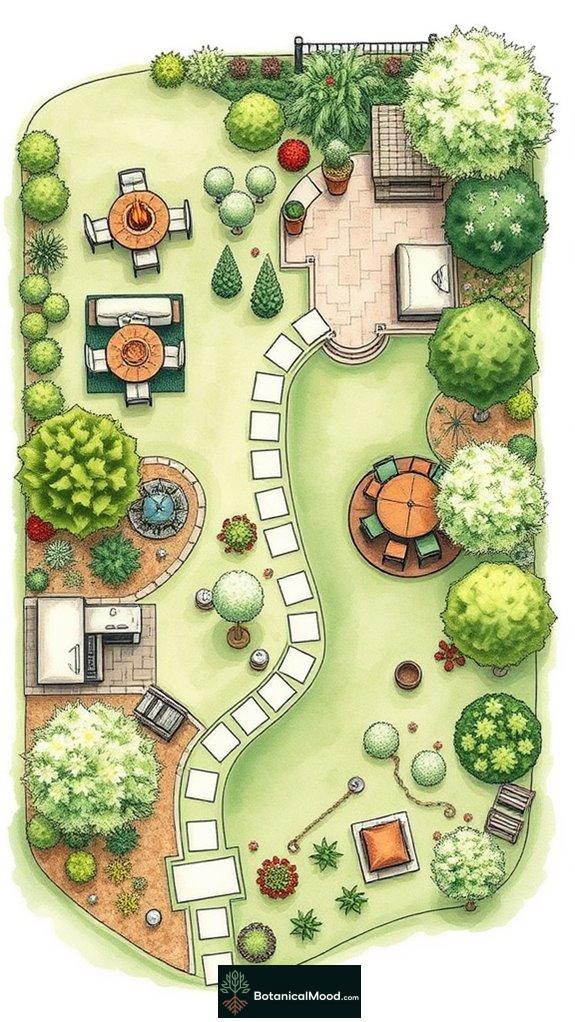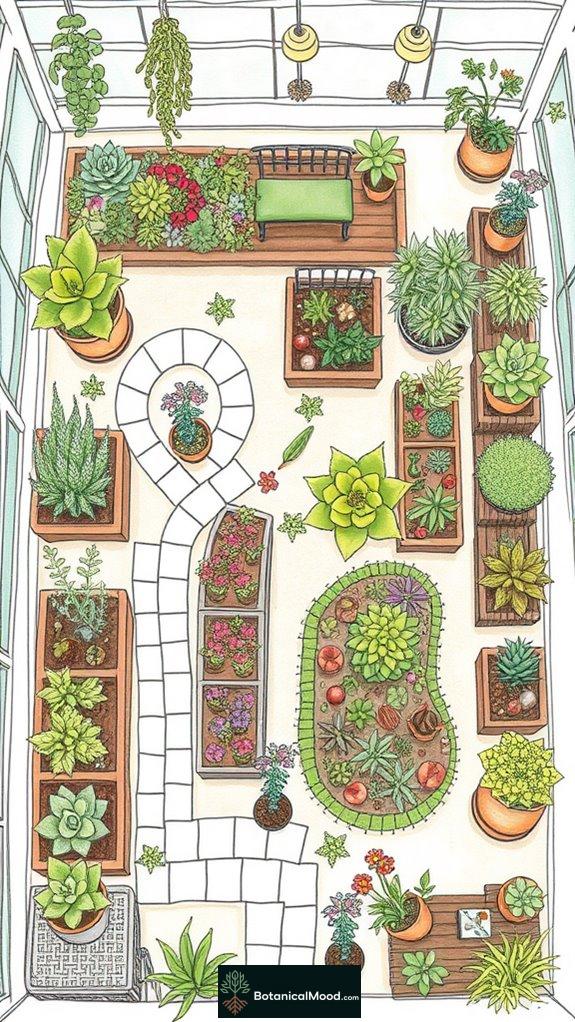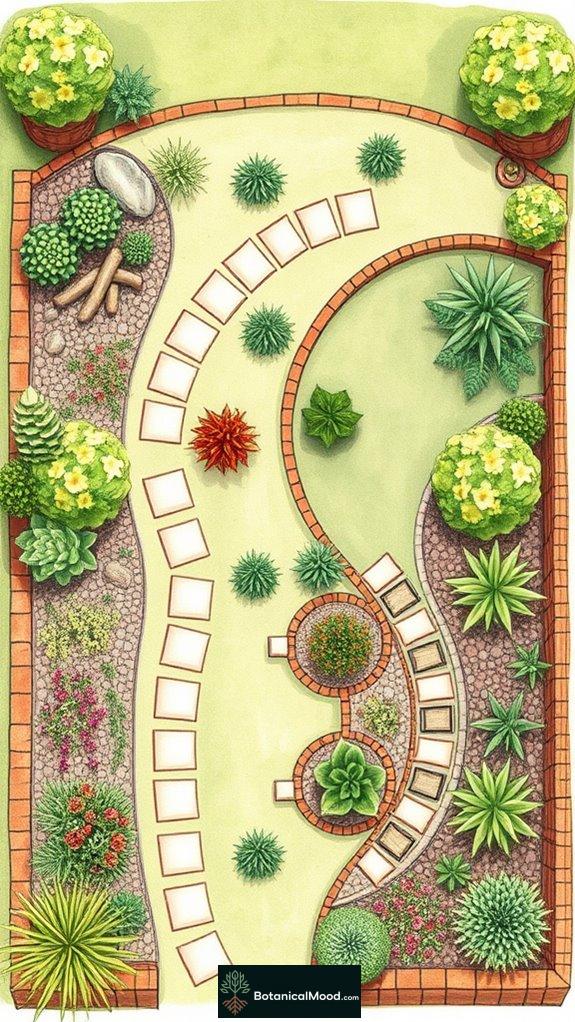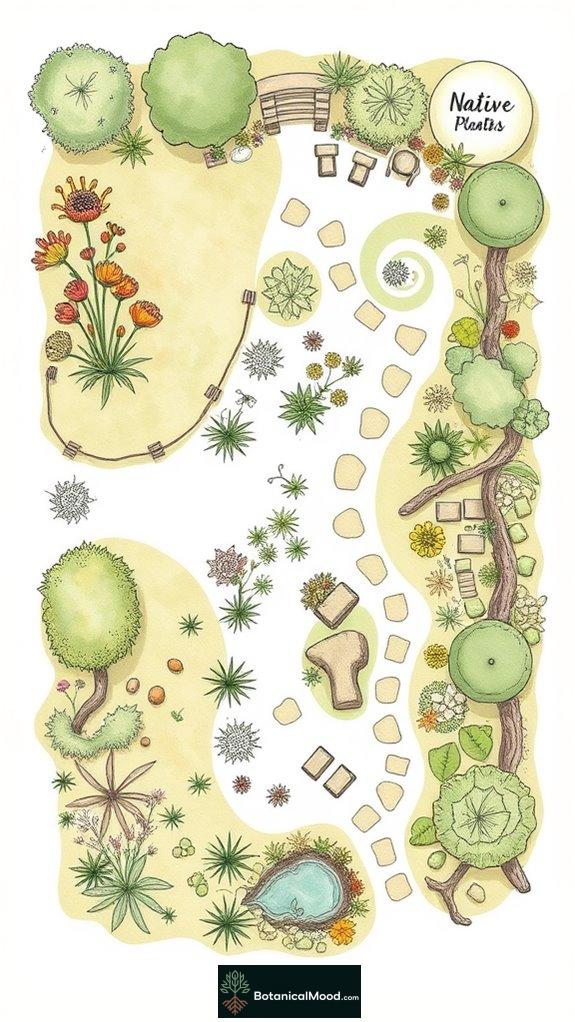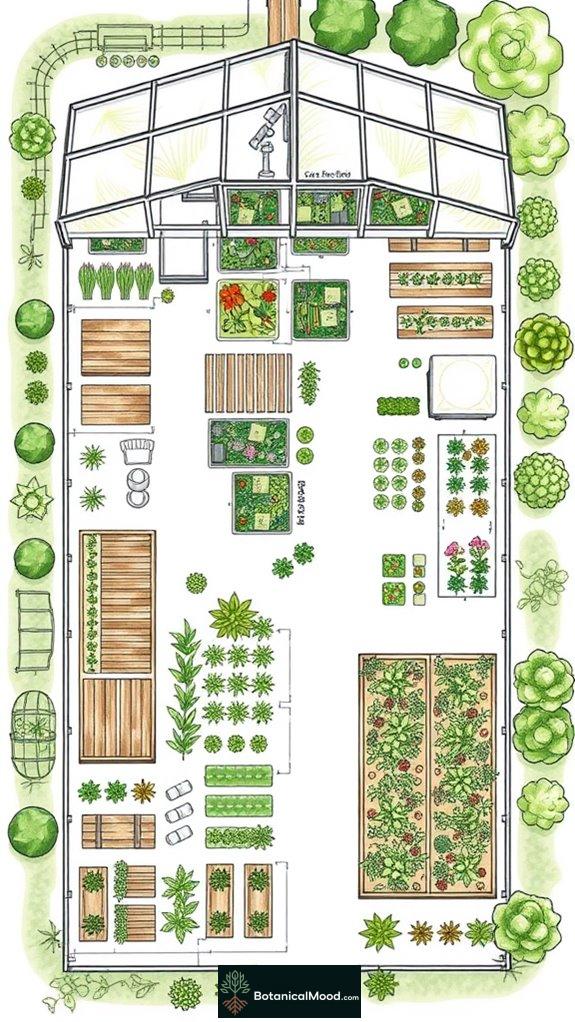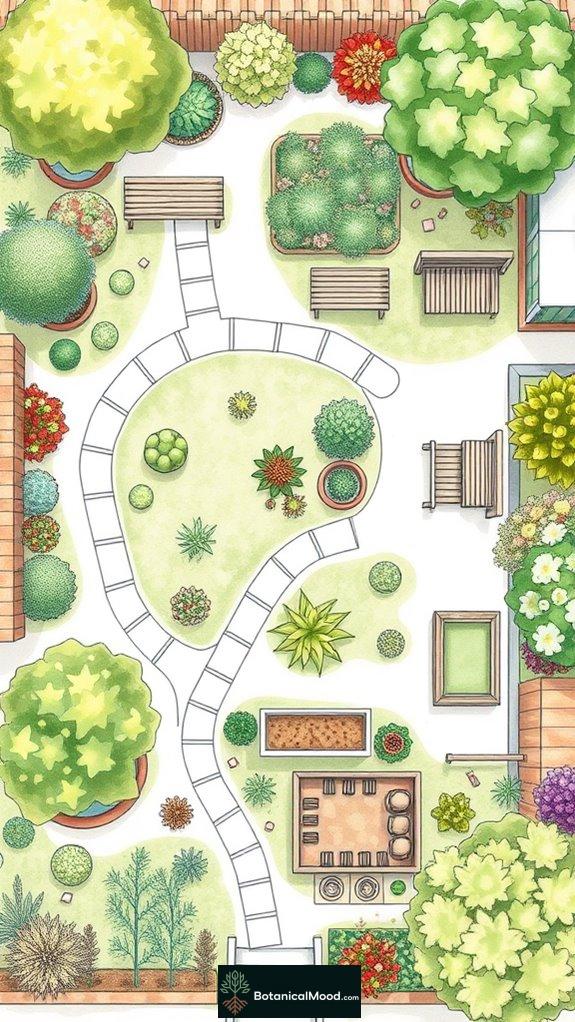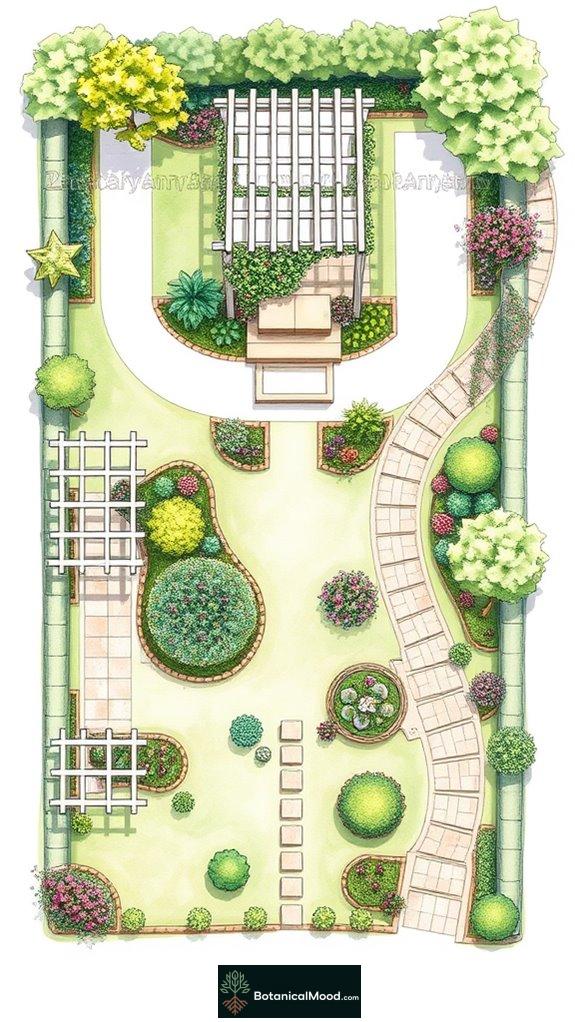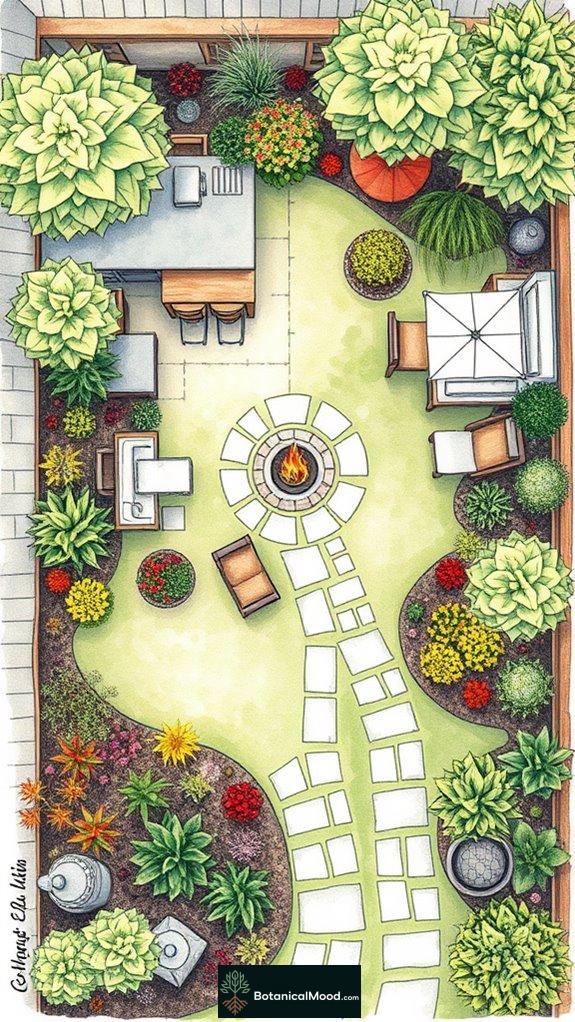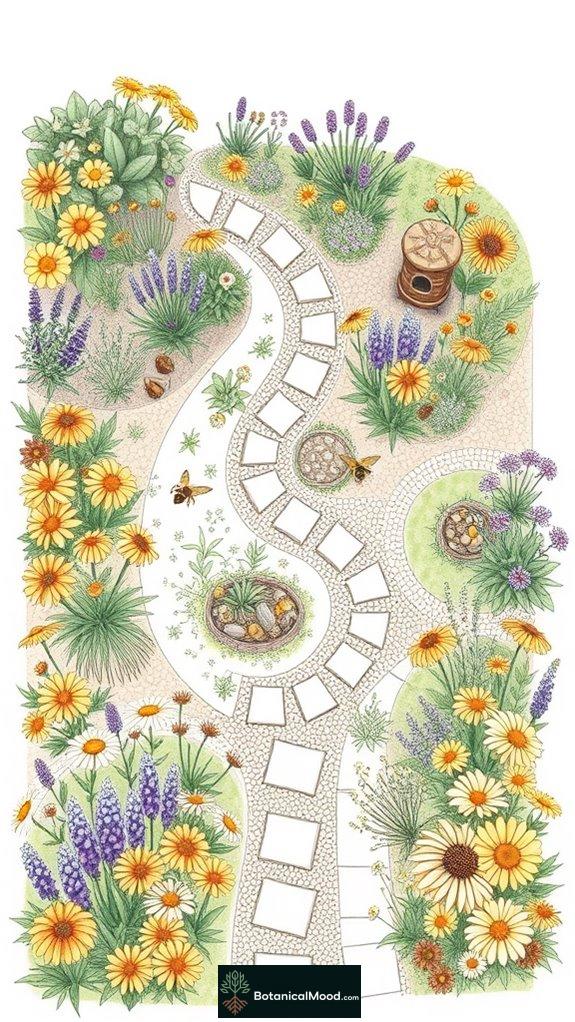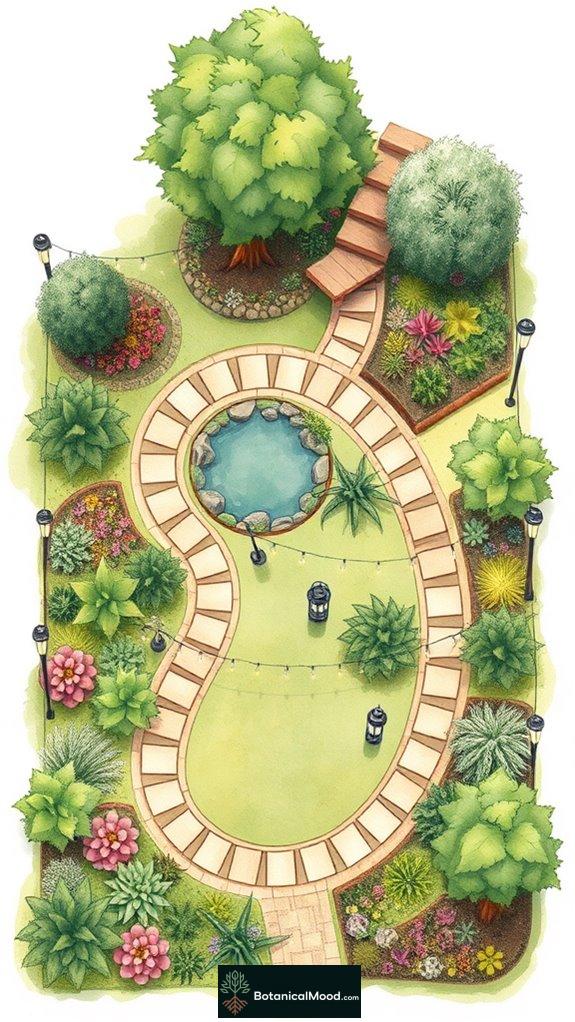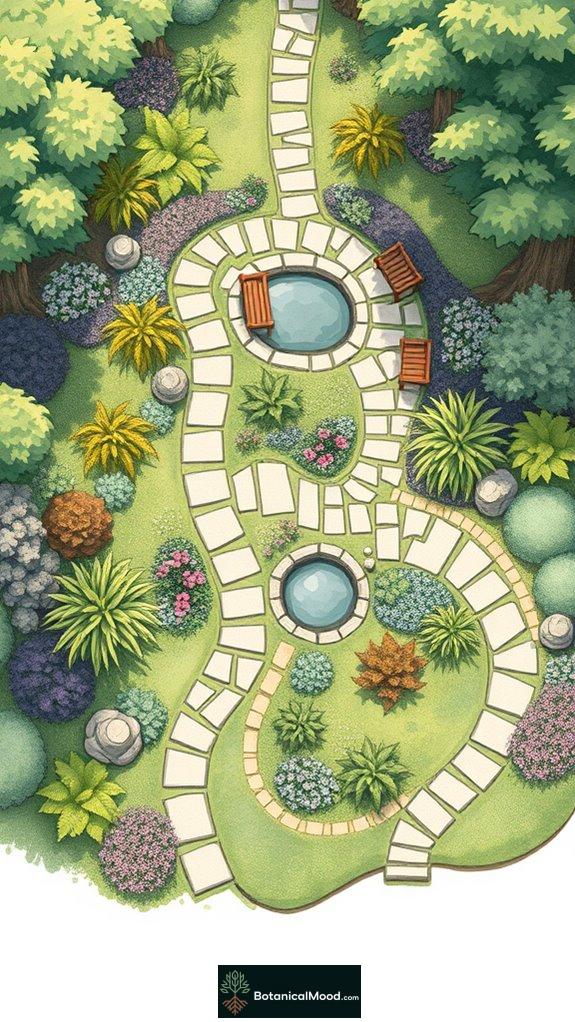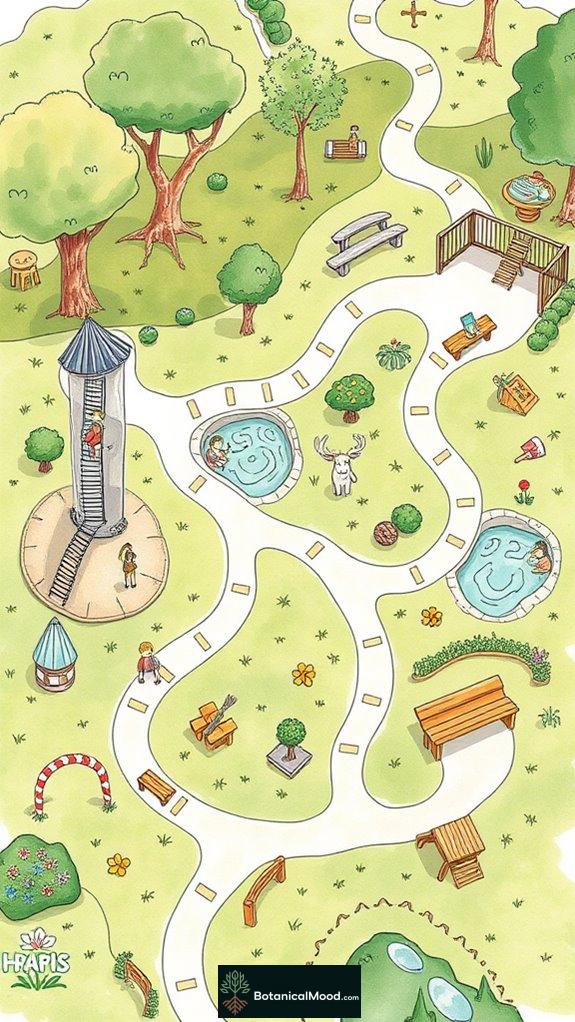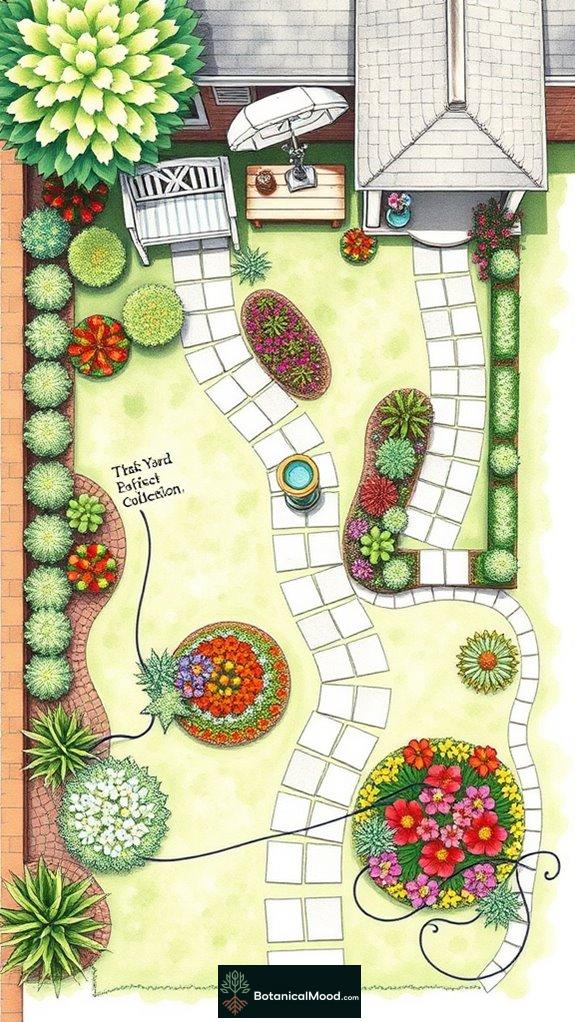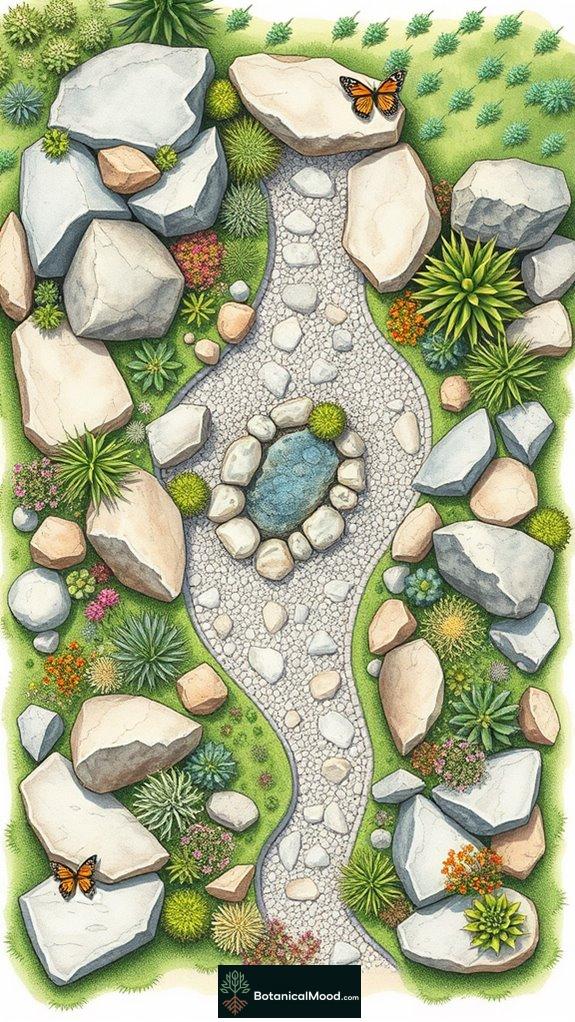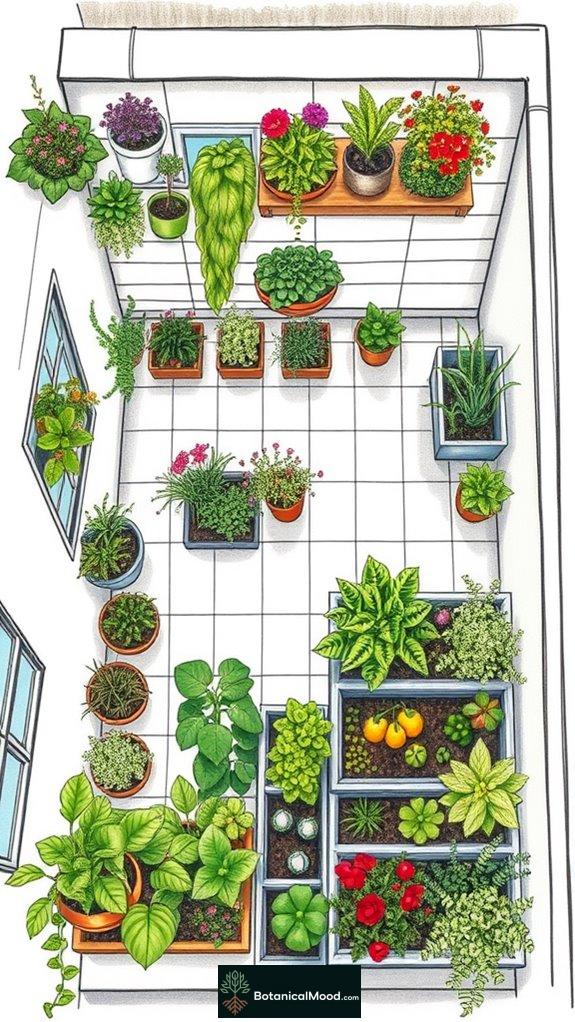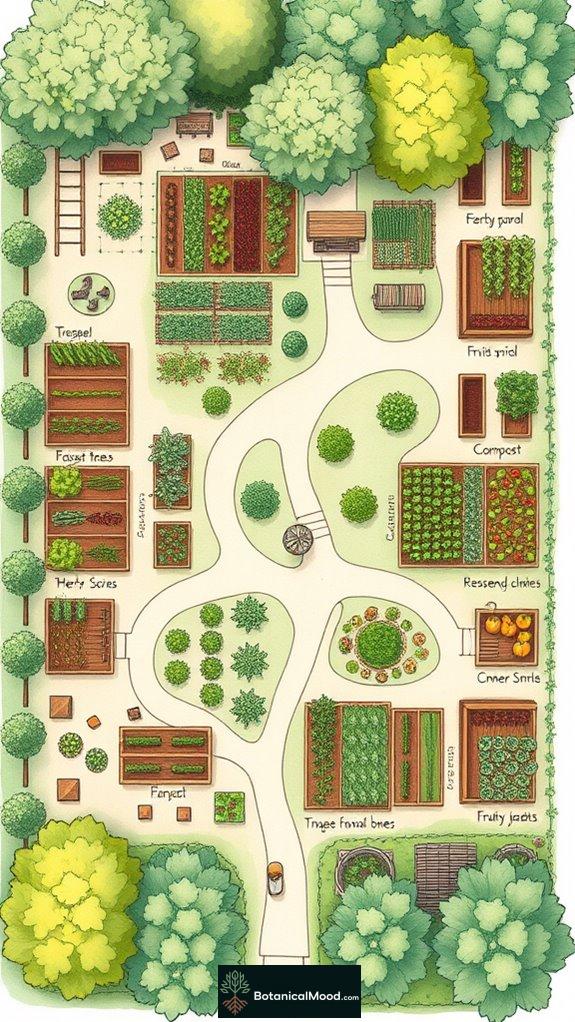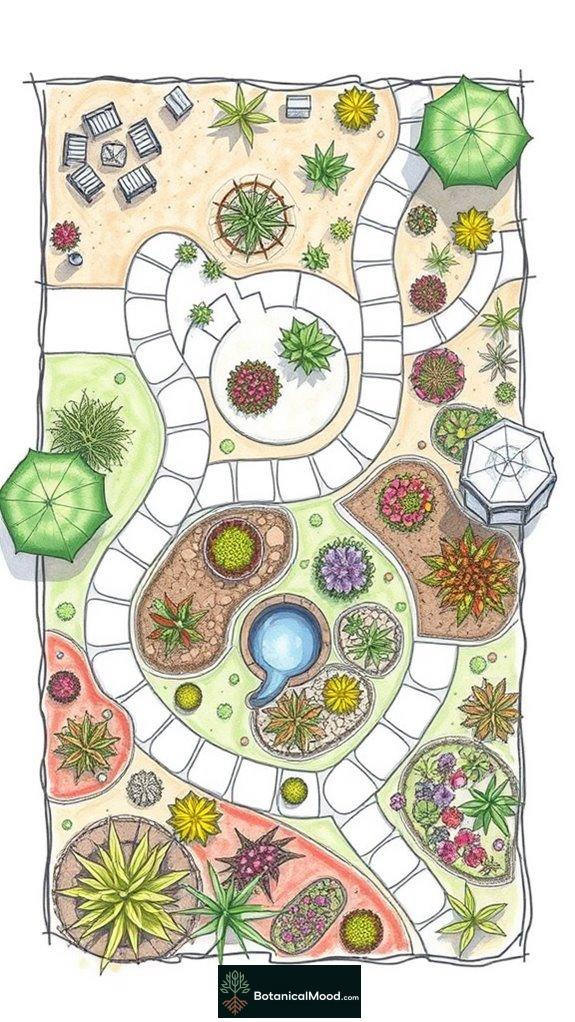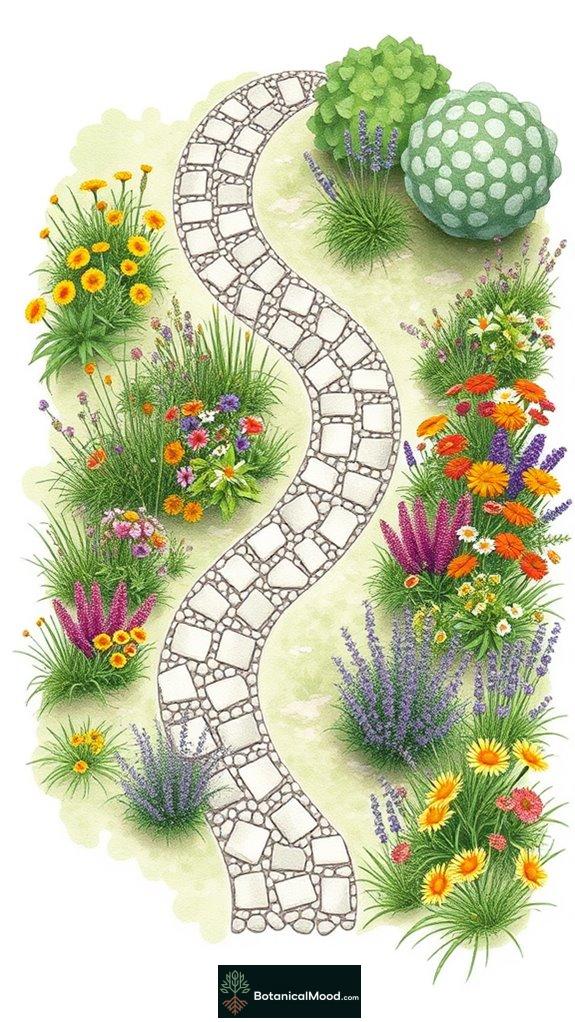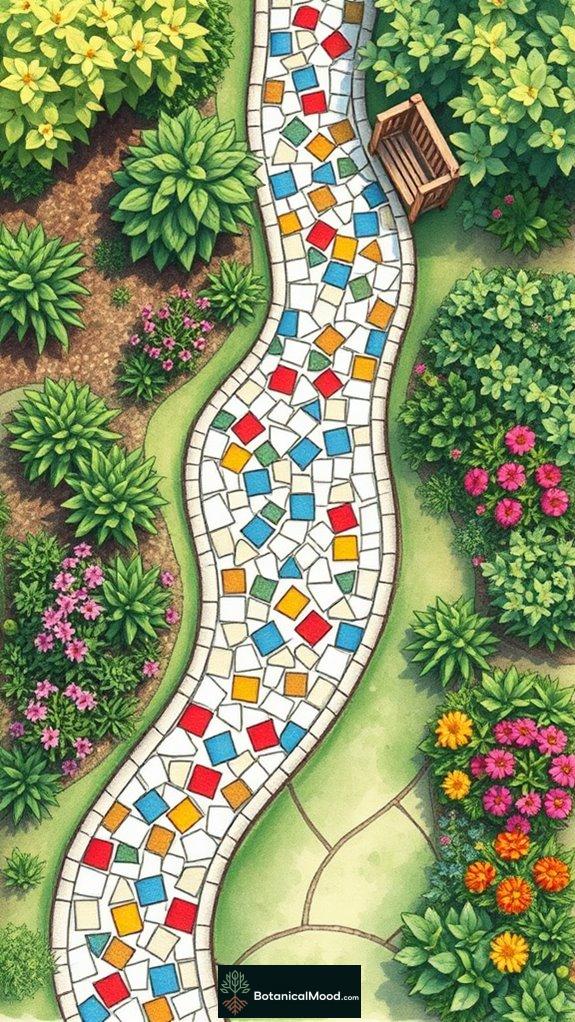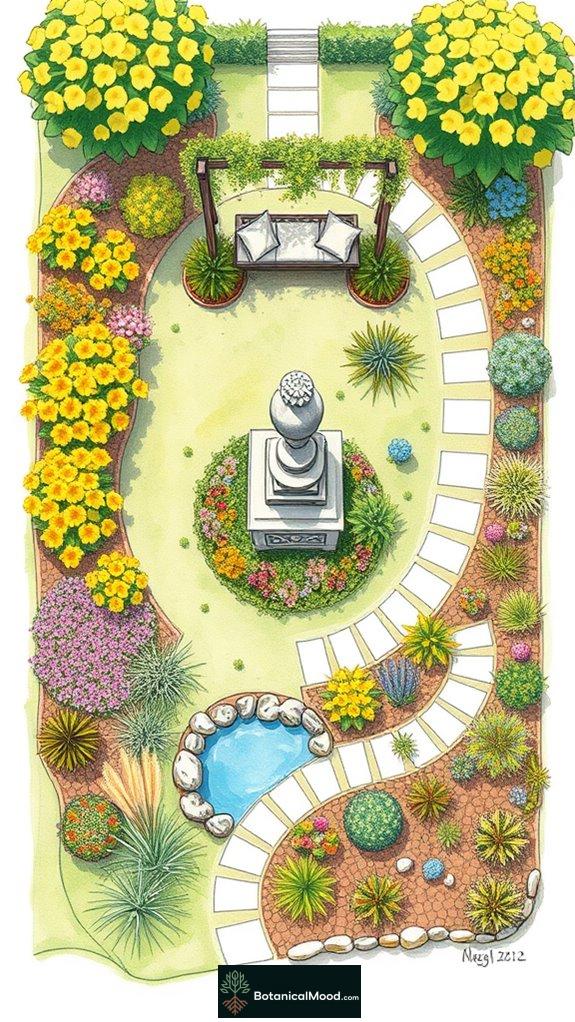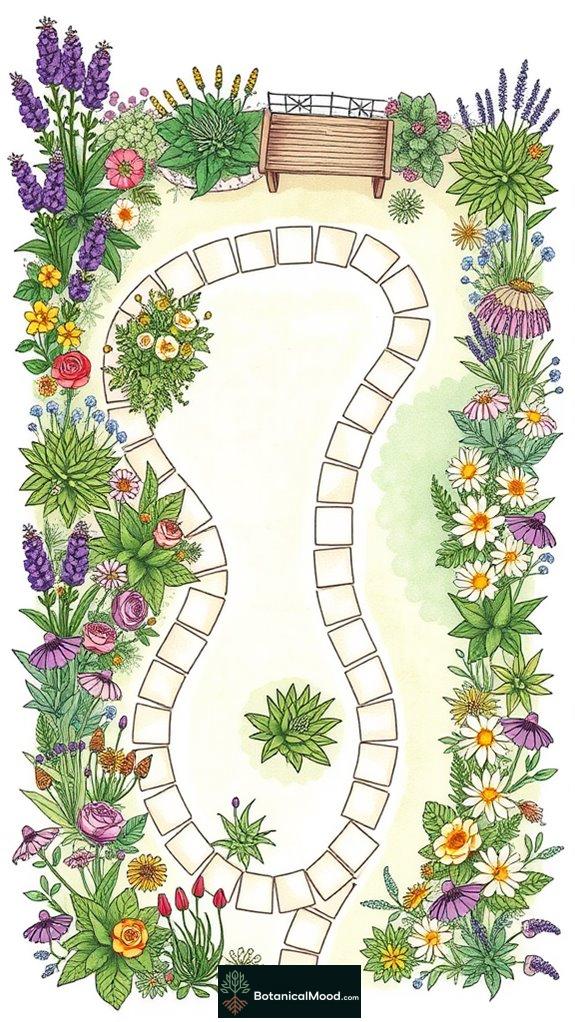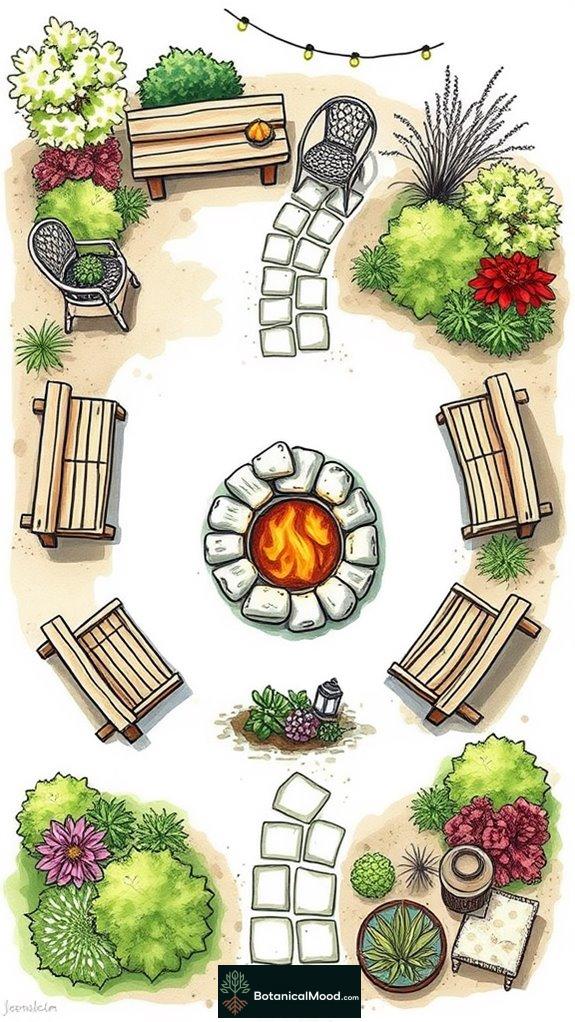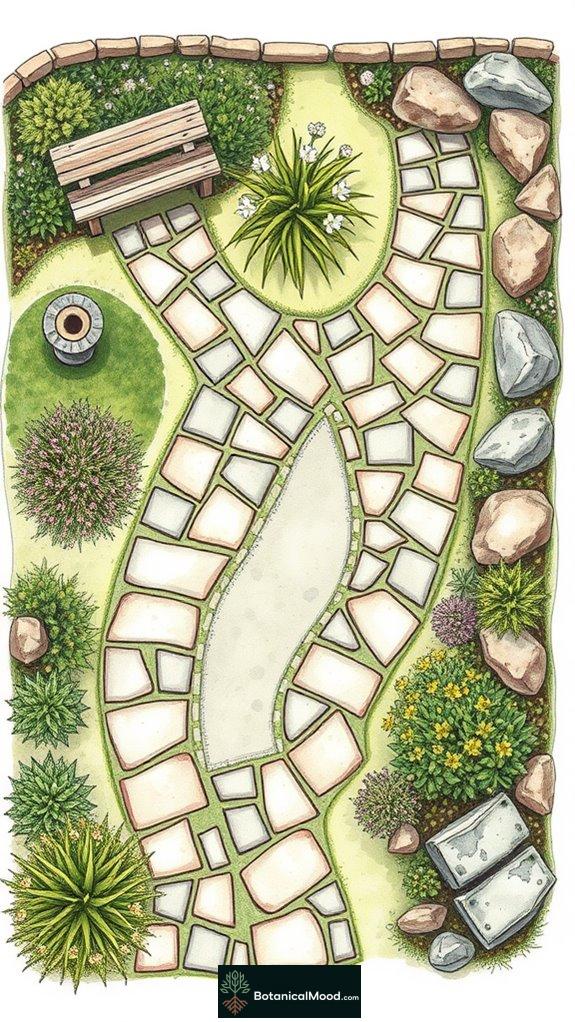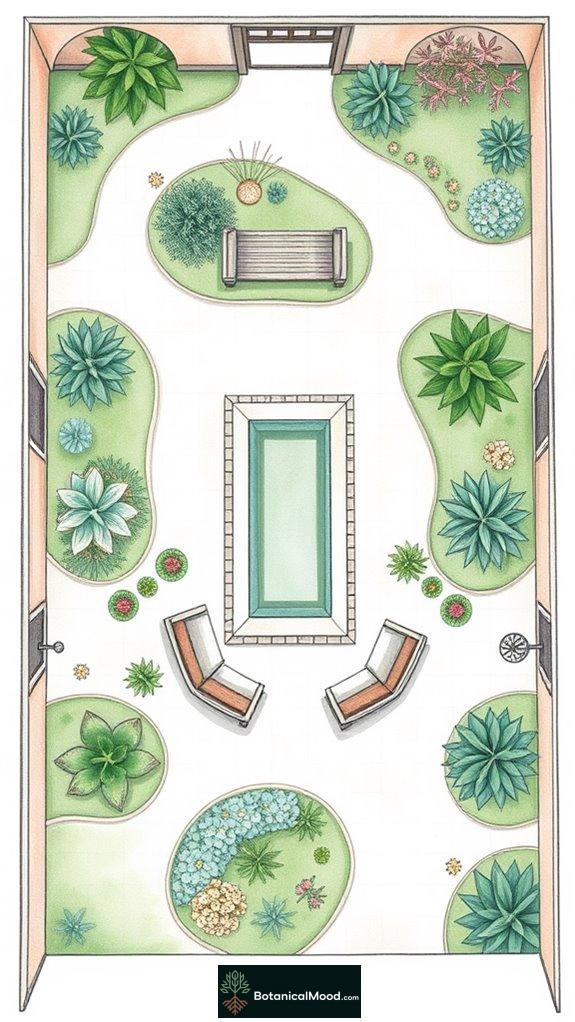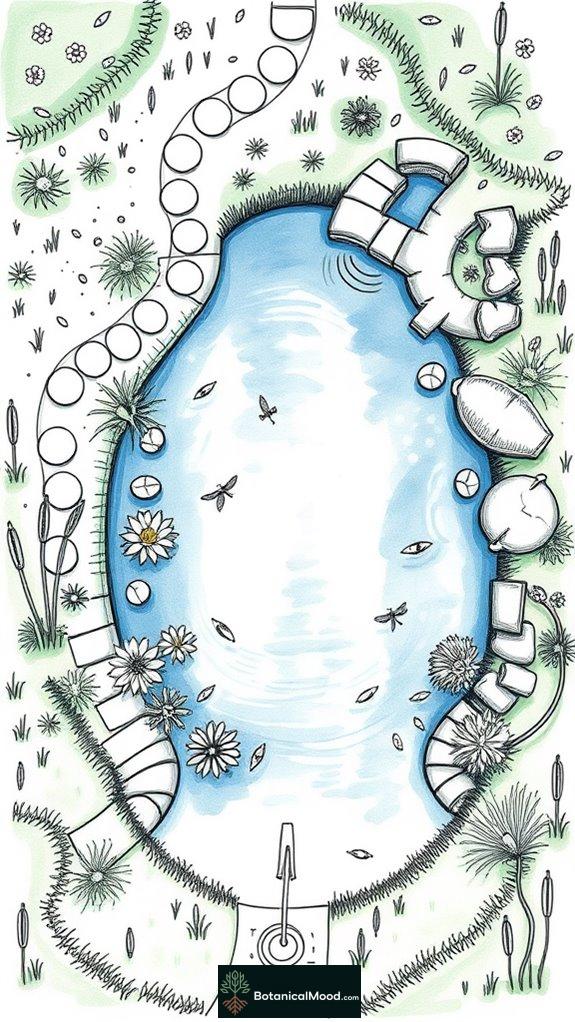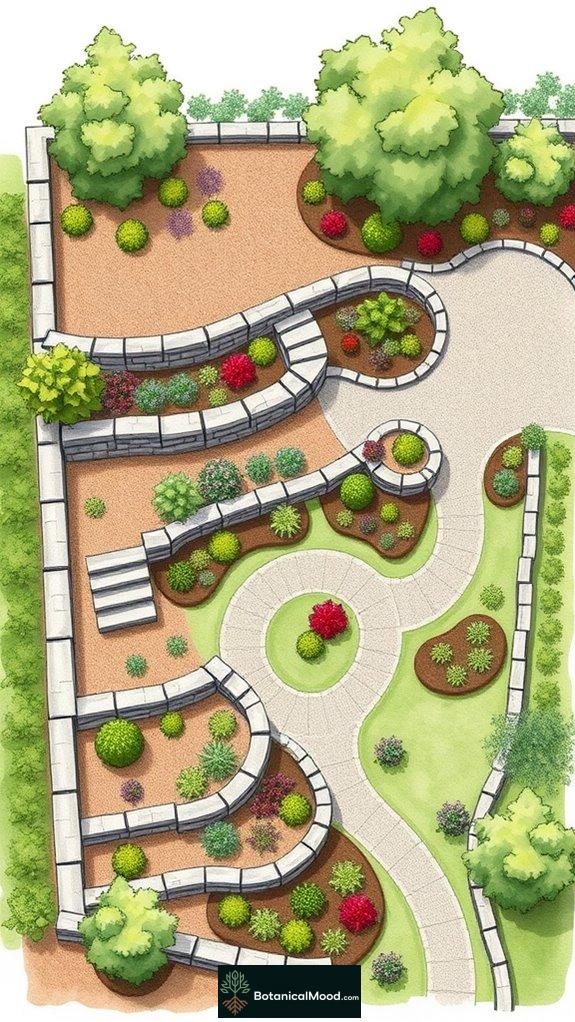Creating a hillside garden? Talk about a rollercoaster ride of emotions!
Let’s be real—I’ve played with dirt while trying to balance aesthetics and that pesky “function” thing. I still remember my first terrace build; I thought I could wing it. Spoiler alert: a mudslide didn’t exactly scream “dream garden.”
I mean, who doesn’t love a bit of masonry action? It screams “structural support,” especially when your plants are getting a little too ambitious. And, oh, those cute little built-in stone benches? I thought I’d be lounging serenely, but my dog had other plans.
Ever thought about how you’ll enjoy cascading water features? I daydreamed of tranquil sounds while battling a raccoon trying to steal my garden.
What are you waiting for? Hillside magic is calling!
The Importance of Native Plants in Sustainable Garden Design
Years ago, I attempted to turn a notoriously tricky slope into a floral paradise. Enter native plants—my saving grace. They’re not just great for drainage and soil health; they also attract local pollinators like butterflies. However, I once learned the hard way that not all native plants play well together. Picture me desperately trying to rescue my sprawling wildflowers from the clutches of aggressive weeds. It was a hot mess!
Through this experience, I grasped the true essence of garden design. It’s not just about the pretty flowers but creating an ecosystem that thrives. From soil composition to thoughtful plant selection, every detail matters. So, embrace the chaos, and remember, even the best gardeners face wild challenges!
Quick Takeaways
- Incorporate terraced levels to enhance visual appeal and ensure safety while maximizing usable outdoor space on slopes.
- Utilize native plants for their resilience, ensuring proper drainage and lower maintenance for hillside gardens.
- Create accessible pathways using stable materials to facilitate ease of movement between different terrace levels.
- Integrate large sculptures or water features to add aesthetic interest and create focal points within the garden design.
- Employ layered planting techniques to promote biodiversity and year-round visual interest while improving soil health.
Balancing Function and Aesthetics in Hillside Terraces
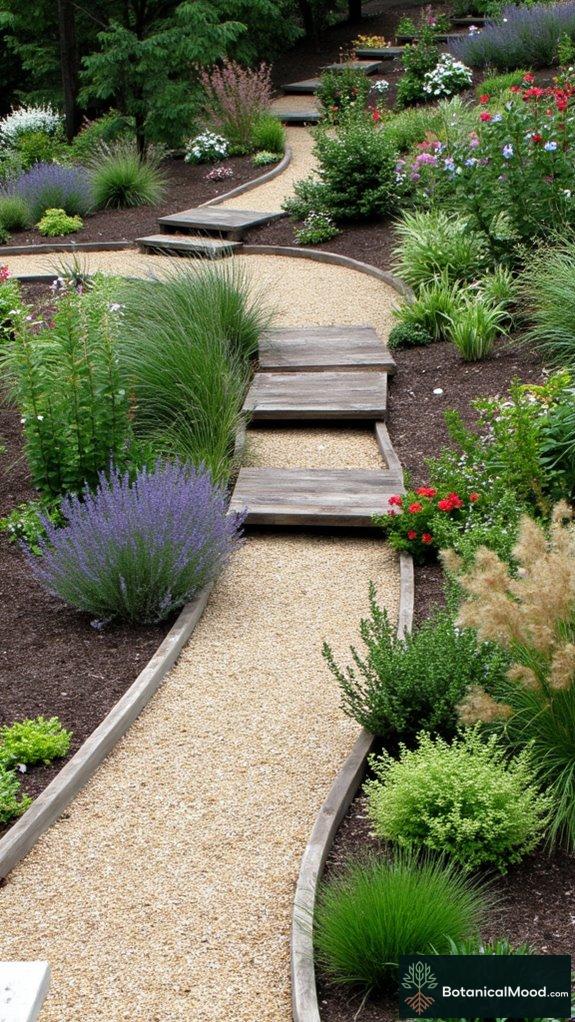
When I consider how to design hillside garden terraces, I often find myself balancing function and aesthetics, since both elements are essential for creating a harmonious space.
Elevating the design involves using sustainable materials, like reclaimed wood or porous pavers, which blend seamlessly with the surroundings.
I incorporate native plants that thrive on slopes, guarantee proper drainage, and maintain soil health.
By layering flowering shrubs and ornamental grasses, I add visual interest year-round.
For innovative solutions, I often explore unique color palettes and textures that invigorate the space.
Integrating sustainable terracing techniques not only enhances the beauty of the landscape but also contributes to ecological health.
My passion for these terraces inspired the creation of Botanical Mood, reflecting my commitment to innovative gardening design.
Innovative Steps and Platforms With Natural Stone
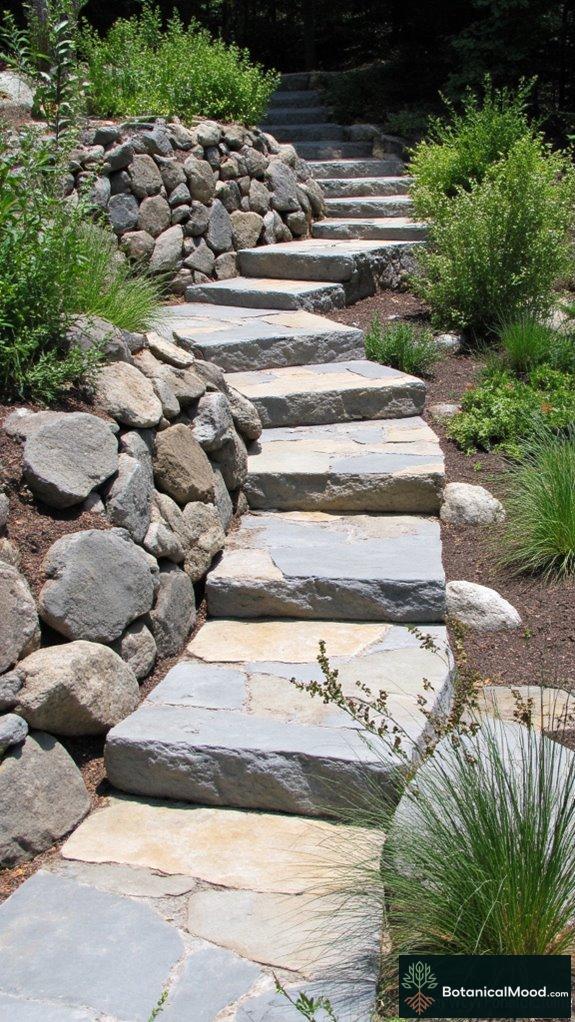
Integrating natural stone into hillside garden terraces not only enhances the aesthetic appeal but also provides practical solutions for traversing slopes gracefully. I’ve discovered that using materials like granite, slate, or limestone creates lasting pathways that blend harmoniously with the surroundings.
Consider innovatively designed steps with varying heights, utilizing textured surfaces to guarantee safety and traction. Pairing these with strategically placed platforms can elevate your garden experience, offering perfect spots for rest and contemplation.
In my own designs, I often combine stone with native plants to enrich biodiversity and celebrate nature’s beauty, making every ascent through the garden a journey worth taking. The use of sculptural retaining walls can further enhance the stability and visual impact of the terracing, allowing for more dynamic garden features.
Masonry Retaining Walls and Water Features

While establishing a robust hillside garden, masonry retaining walls can serve not only as structural supports but also as stunning visual elements that enhance the overall design.
Their rugged beauty, often complemented by local stone varieties such as basalt or sandstone, creates an inviting backdrop for vibrant plantings.
Integrating water features, like a cascading fountain or gentle stream, not only adds auditory delight but also promotes tranquility.
I’ve found that combining these elements fosters a serene, picturesque environment.
The elegance of stone paired with the soothing sound of water is truly a game-changer for any hillside project I endeavor to create.
Sustainable Planting Strategies for Sloped Gardens

As I explore sustainable planting strategies for sloped gardens, it’s essential to contemplate not only the visual impact but also the environmental implications of our choices.
Embracing native plants is a game-changer, as they require less water and support local wildlife.
Embracing native plants not only conserves water but also enriches local ecosystems and supports wildlife.
I often incorporate ground covers like creeping thyme or sedum to stabilize soil and prevent erosion.
Utilizing terracing with permeable materials allows water to hydrate the soil effectively, while layered planting creates visual interest and biodiversity.
Creative Seating Solutions in Terrace Designs

In terrace designs, six innovative seating solutions stand out for their functionality and aesthetic appeal, transforming steep terrains into inviting gathering spaces.
First, consider built-in stone benches that blend with natural scenery, offering durability and rustic charm.
Next, modular seating options, like weather-resistant outdoor sofas from brands like Kettal or Dedon, provide flexibility for different occasions.
Reclaimed wood platforms can create intimate nooks, while sleek metal chairs inject modern elegance.
Don’t overlook hanging swings or hammocks for whimsical relaxation areas.
These creative seating elements not only enhance the visual harmony of a terrace but foster connection, elevating outdoor experiences beautifully.
Multi-Level Patios for Enhanced Outdoor Living

Multi-level patios offer a dynamic approach to outdoor living that seamlessly enhances the usability of your space while accommodating varying elevations and views.
By incorporating materials like natural stone or pavers from brands such as Techo-Bloc, you can create textured layers that harmonize with the surroundings.
Consider integrating built-in seating and planters to deepen the functionality and aesthetic appeal.
Elevating dining areas alongside fire pits magnifies the outdoor experience, inviting social gatherings.
In designing these spaces, I aim to evoke a sense of tranquility and joy, leading to vibrant moments in the beautiful, curated gardens many aspire for.
The Role of Natural Elements in Rustic Homes

Natural elements are essential in creating the warm, inviting atmosphere characteristic of rustic homes, as they bring the beauty of the outdoors right into your living space.
Incorporating reclaimed wood beams, stone accents, and vibrant plants fosters a genuine connection with nature, which I believe enhances the overall aesthetic. Using earthy color palettes, like terracotta and moss green, complements natural textures, creating harmony in design.
Unique features, such as live-edge furniture and artisanal crafts, can elevate a home’s character while remaining true to rustic principles.
At Botanical Mood, I explore how these elements encourage innovation in garden design, inspiring a seamless indoor-outdoor experience.
Drought-Tolerant Landscapes for Low Maintenance
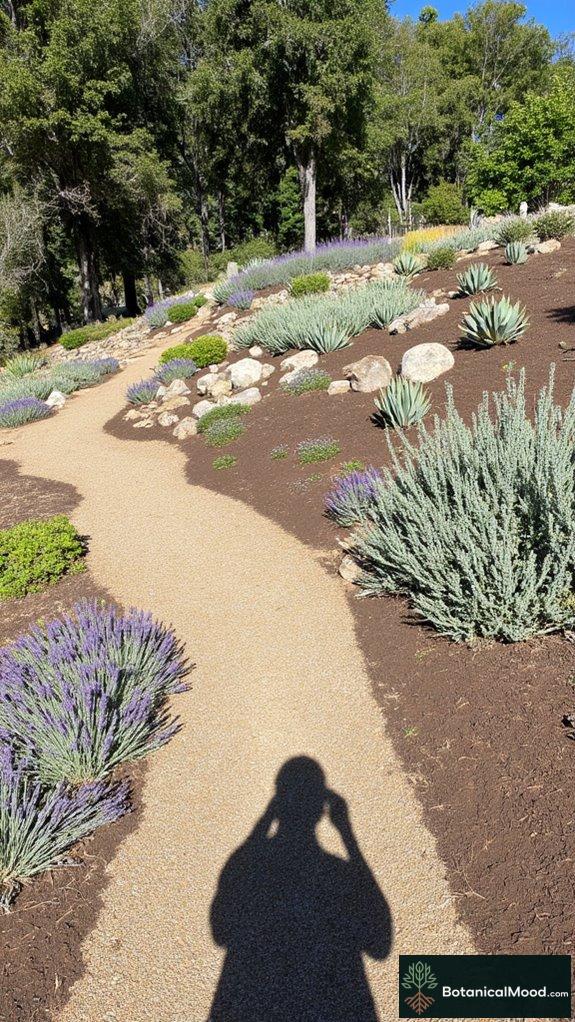
Creating a drought-tolerant environment not only conserves water but also simplifies garden maintenance, allowing you to enjoy your outdoor space without the constant demands of traditional gardening.
Consider these three innovative elements for your hillside terrace:
- Native Plants: Select flora like lavender, succulents, or sage that thrive in your local climate.
- Drip Irrigation: Implement a system targeting root zones, minimizing water loss and maximizing efficiency.
- Mulching: Apply organic mulch to retain moisture in the soil, suppress weeds, and add nutrients.
These strategies not only beautify your setting but also contribute to a sustainable gardening approach, something I cherish at Botanical Mood.
Integrating Container Gardens Into the Slope

How can you transform a sloping terrain into a vibrant tapestry of container gardens?
By carefully selecting innovative containers, such as self-watering pots and vertical planters, you can utilize diverse herbs, flowing grasses, and colorful blooms that thrive in unique microclimates.
Consider integrating lightweight materials like fiberglass or eco-friendly options from renowned brands such as Lechuza.
Layering textures and colors—like the soft silver of lavender juxtaposed against vibrant geraniums—creates an engaging visual experience.
As I developed Botanical Mood, I aimed to inspire and showcase how these container gardens not only beautify slopes but also enhance the interplay between nature and design.
The Importance of Accessibility in Garden Terraces
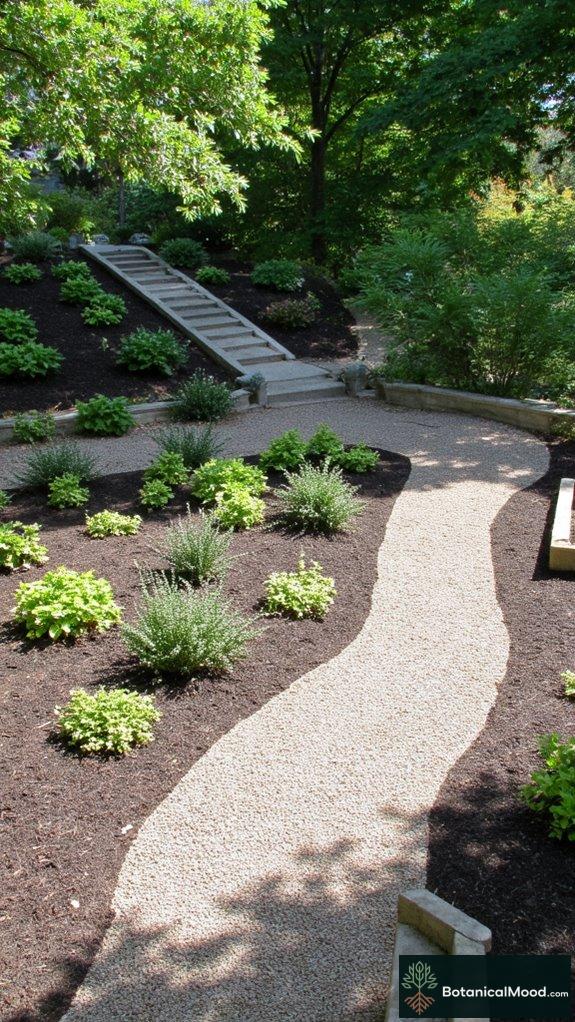
While the allure of container gardens on sloped terrains is undeniable, the conversation about accessibility in garden terraces is equally important.
Consider these essential aspects:
- Pathway Design: Guarantee wide, stable paths, utilizing materials like decomposed granite for a smooth journey through your garden.
- Plant Selection: Opt for low-maintenance plants that thrive in your local climate, minimizing upkeep and maximizing enjoyment.
- Innovative Features: Incorporate features like raised beds or tiered planting to reduce bending and make care easier.
Creating accessible garden terraces not only enhances usability but also elevates the overall aesthetic, embracing the beauty of functional design.
Visual Cohesion With Home Architecture

Achieving visual cohesion with your home architecture can greatly enhance the overall charm of hillside garden terraces, as it creates a seamless change between indoor and outdoor spaces.
To evoke harmony, I recommend selecting planting palettes that resonate with your home’s exterior colors. For instance, earthy tones like terracotta pots can complement warm brick facades, while sleek glass barriers enhance modern aesthetics.
Incorporating architectural elements, such as trellises or pergolas, can bridge the gap between nature and design. Keep in mind, your terrace can echo your unique style, inspiring energy and continuity that reflects the essence of spaces I’ve aimed to encapsulate on Botanical Mood.
Unique Features: Fire Pits and Gathering Spaces
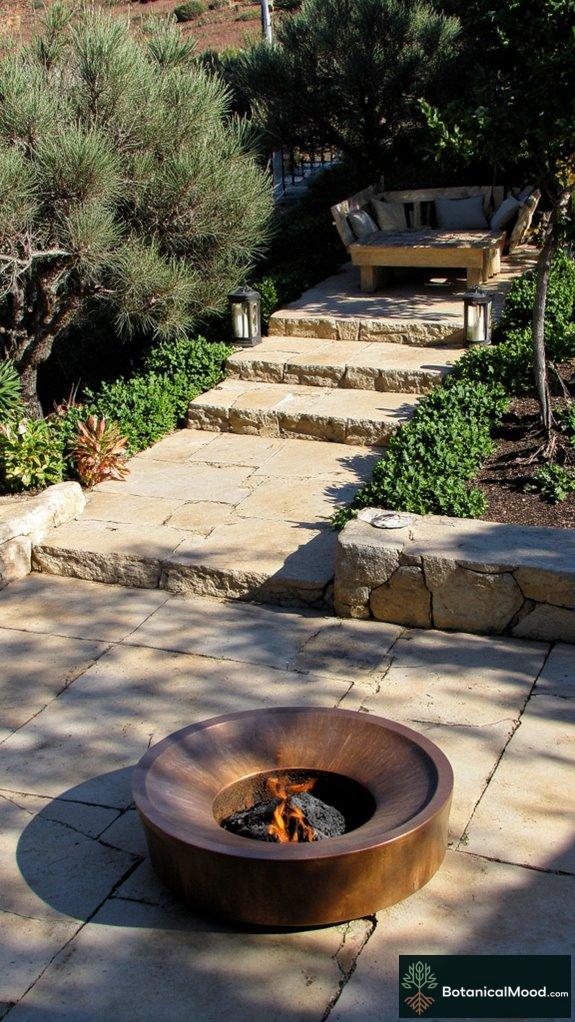
Incorporating unique features like fire pits and gathering spaces can profoundly transform hillside garden terraces, inviting a warm and communal atmosphere that fosters connection with family and friends.
Here are three innovative ideas to elevate your terrace design:
- Custom Fire Pits: Opt for a sleek, modern design using heat-resistant materials like steel or concrete for a contemporary touch.
- Multi-Level Seating: Create adaptable seating arrangements using organic materials, ensuring comfort and flexibility for various gatherings.
- Mood Lighting: Integrate solar-powered lights or lanterns for enchanting evenings, enhancing safety while creating intimacy under the stars.
These elements can create a truly enchanting hillside retreat.
The Impact of Local Ecology on Terrace Design

The design of hillside garden terraces deeply reflects the unique ecological characteristics of the region, influencing not only the choice of plants but also the overall layout and materials used.
In my experience, incorporating native species creates harmony with the local environment, enhancing ecological resilience. For instance, in Mediterranean climates, drought-tolerant plants like lavender and rosemary thrive, while tropical regions excel with vibrant foliage such as heliconias and ferns.
Furthermore, using locally sourced stones or reclaimed wood not only reduces environmental impact but also adds authenticity and charm. Every aspect must resonate with nature’s palette, ensuring beauty marries functionality, as I endeavor to achieve with Botanical Mood.
Terraced Garden Slope Layout Techniques
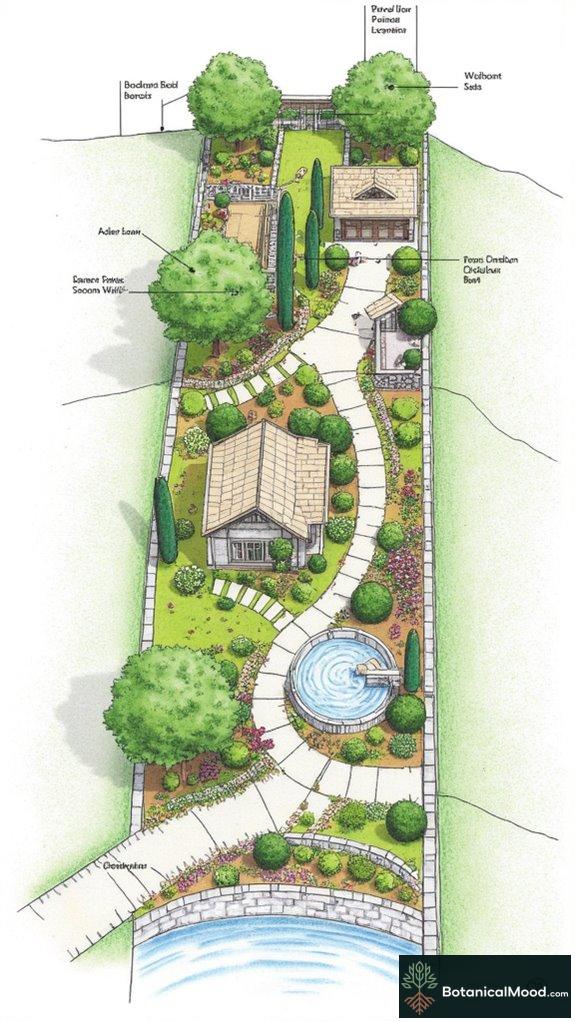
Creating a functional and visually appealing terraced garden begins with an understanding of the slope layout techniques that dictate both the design and sustainability of the installation.
Here are three essential steps:
- Calculate the Slope: Determine the vertical rise and horizontal run to refine your terrace dimensions and angles.
- Sketch Your Layout: Use graph paper or digital design tools to visualize levels and plant placements.
- Prioritize Accessibility: Plan your pathways and stairways, ensuring safe and convenient movement between terraces while enhancing visual flow. Additionally, consider the need for a natural stone retaining wall to prevent soil erosion, which is critical for the longevity of your garden.
These techniques not only improve accessibility but also facilitate long-term functionality and beauty in your hillside garden.
Innovative Retaining Wall Techniques

While exploring innovative retaining wall techniques, you’ll discover that the right choices can’t only stabilize your hillside but also enhance its aesthetic appeal.
Using concrete masonry units (CMUs) with a stone veneer creates a harmonious blend of strength and beauty. Gabion walls, filled with natural stones, offer both structural integrity and ecological benefits.
Combining CMUs with stone veneer brings together durability and style, while gabion walls provide both strength and ecological advantages.
I find that integrating living walls introduces vibrant plant life directly into the design—a smart strategy for sustainable landscaping.
Remember to guarantee effective drainage by employing weep holes and gravel backfill, safeguarding your wall’s longevity. These elements not only support the soil but also showcase your hillside garden as a fascinating retreat.
Terrace Layering for Drainage
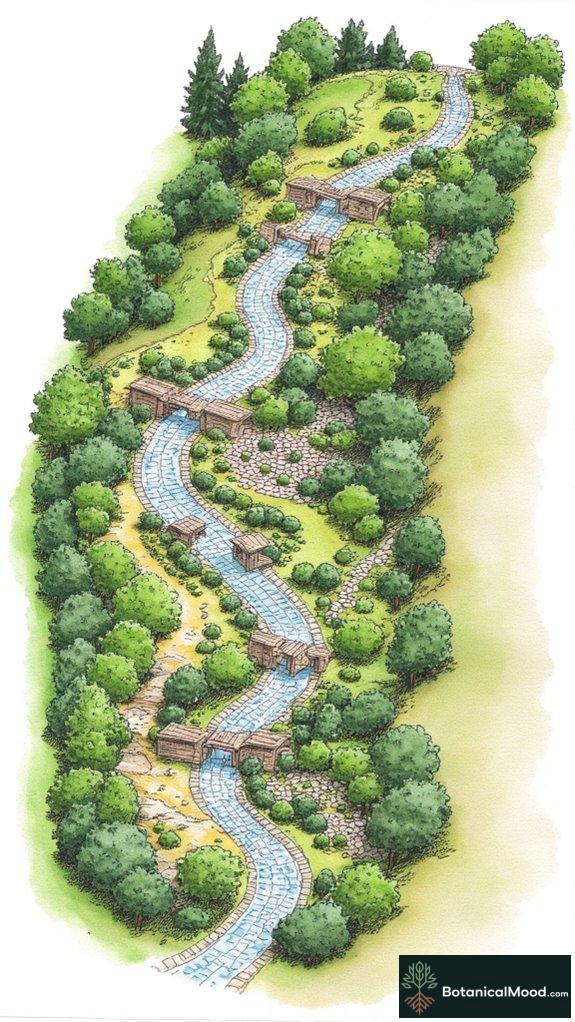
Terrace layering for drainage not only optimizes slope management, but also enhances the garden’s overall health and aesthetics, making it an essential component in terrain design.
Here are three innovative strategies:
- Integrate French drains to channel water efficiently, minimizing erosion risks.
- Utilize dry creek beds lined with smooth stones to mimic natural flow and decrease runoff.
- Incorporate microclimates between layers, promoting moisture retention and conserving water efficiently.
These methods not only improve drainage but also contribute organically to the beauty of your hillside garden, reinforcing my passion for creating spaces that foster ecological balance.
Contemporary Terraced Planting Schemes
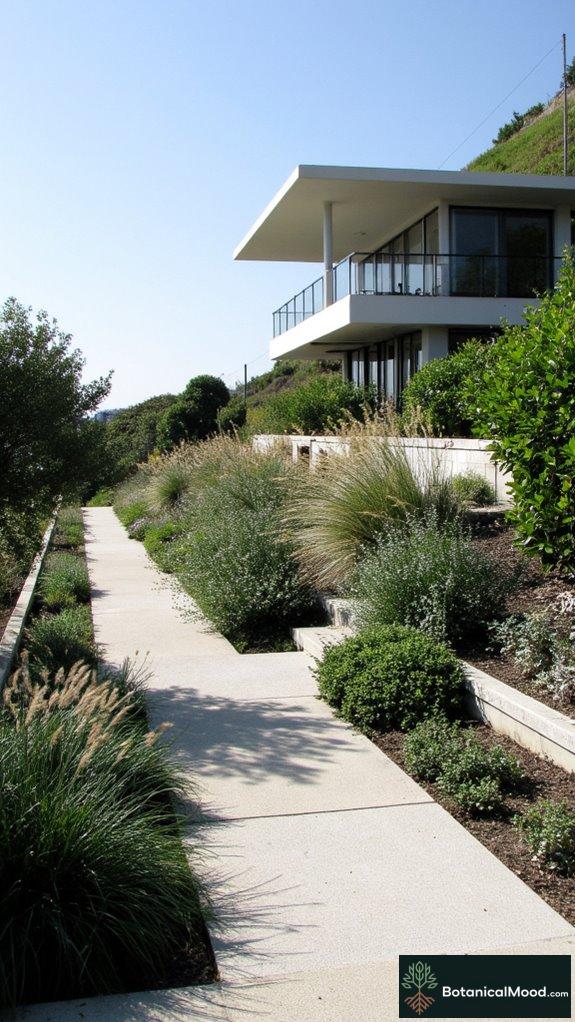
Contemporary terraced planting schemes exemplify the harmony of functional design and aesthetic appeal, inviting garden enthusiasts to explore innovative environments that reflect modern values.
In these gardens, strategic plant selection and placement are essential. I often choose sun-loving varieties for upper tiers and shade-tolerant plants below, ensuring a dynamic visual flow.
Taller plants enhance the lower terraces, while grasses like Festuca emphasize sleek lines with minimal irrigation needs. Moreover, climbing plants on trellises optimize vertical space, creating layers.
Incorporating a monochromatic color palette fosters sophistication, enhancing the overall minimalist design I’m passionate about. It’s a beautiful fusion of art and nature that transforms hillside spaces.
Decoration With Terraced Garden Slope Solutions
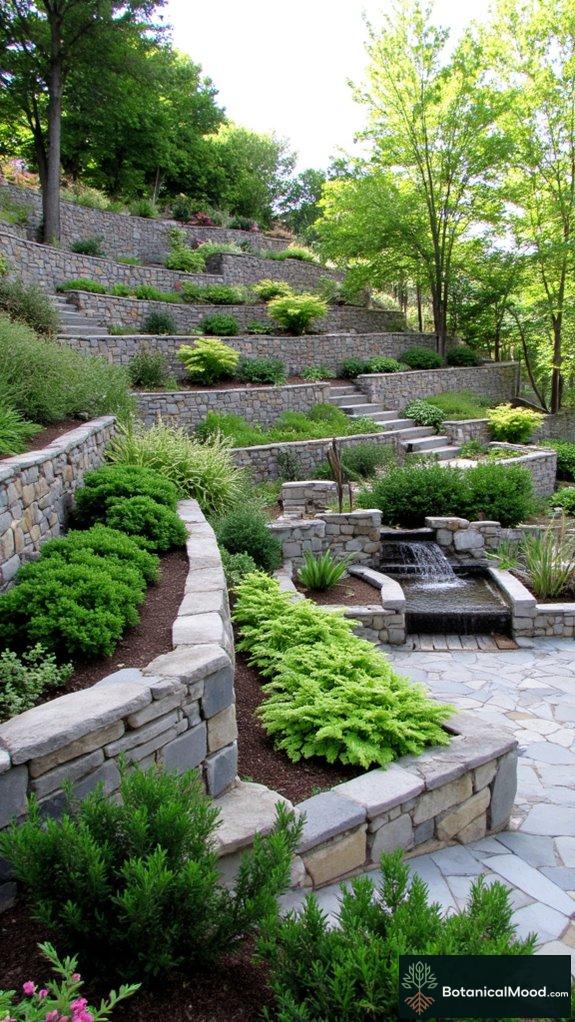
How can I transform a hillside garden into a stunning space that’s both functional and beautiful?
- Use natural materials like stones and pavers for visually striking terraced walls.
- Integrate shade-tolerant plants, such as ferns and perennials, to enhance biodiversity.
- Design engaging features like cascading water elements and rustic seating areas for relaxation.
Incorporating innovative solutions like DIRT LOCKER® planters not only stabilizes the slope but also promotes vibrant plant growth.
Meet the Garden Visionary
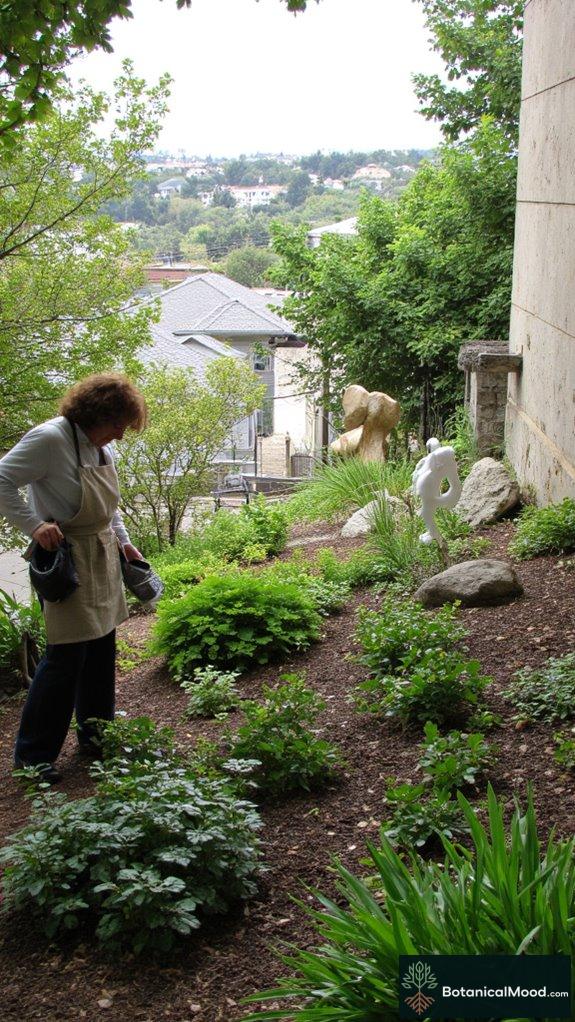
Bonnie Berk, a Seattle native, longed for a garden that embraced her steep front yard while nurturing her creativity and passion for nature. Inspired by the beauty of terraced environments, she sought a space that would be both functional and inviting.
Through a thoughtful design process, Berk collaborated with terrain architects and designers to transform her front yard into a stunning terraced garden. She employed techniques like soil stabilization and strategic plant placement, ensuring that the design harmonized with the breathtaking views of her neighborhood while maintaining ecological integrity.
To bring her vision to life, Berk utilized tools like a soil auger and garden trowels while incorporating beautiful accessories such as large sculptures from local artisans and carefully selected native plants sourced from local nurseries.
She partnered with horticulturists who provided invaluable perspectives into drought-tolerant species that thrive in her region, enhancing the garden’s sustainability and aesthetic appeal.
Renowned Garden Designers and Influencers
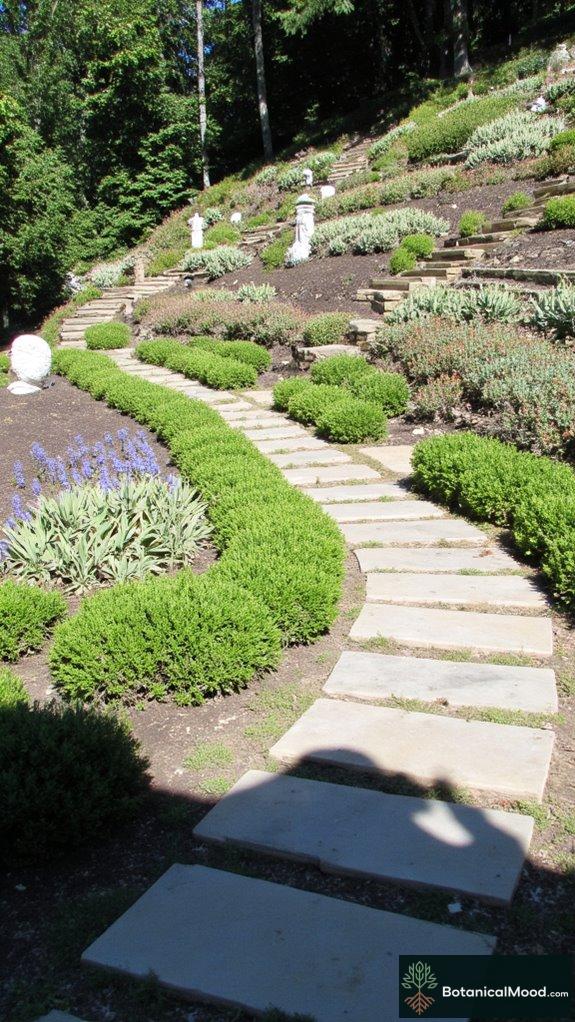
Creating a remarkable hillside garden is a journey led by talented designers who understand how to transform steep, challenging terrain into breathtaking views.
Bonnie Berk’s use of terraces and large sculptures evokes safety amidst stunning foliage, while Brooks Kolb embraces gentle curves, enhancing privacy and drainage with formal water features.
Dan Pearson thrives on natural settings, utilizing streams and ditches to enrich the ecological narrative. Meanwhile, Peter Berg seamlessly integrates footbridges with stone terraces for habitat creation.
John Wyer’s winding paths and textured bricks honor mid-century aesthetics. These innovative approaches inspire my passion for hillside garden design, reminding me how beauty and function can coexist in splendid harmony.
Garden Design FAQ
How Do I Maintain Soil Health on a Hillside Terrace?
To maintain soil health on a hillside terrace, I regularly implement practices like cover cropping, composting, and mulching.
Cover crops, such as clover or rye, enrich the soil while preventing erosion. I also add compost to enhance nutrients and organic matter.
To combat runoff, I create contour beds that follow the land’s natural slope. These techniques not only nurture my garden’s importance, but they also inspire the sustainable aesthetic I cherish at Botanical Mood.
What Are the Best Plant Varieties for Steep Slopes?
For steep slopes, I recommend drought-tolerant perennials like Agastache, Echinacea, and Sedum, which add vibrant colors and thrive in well-drained soil.
Ornamental grasses, such as Calamagrostis, provide movement and texture, while hard-working groundcovers like Creeping Thyme help stabilize soil and create lush visuals.
Mixing different heights and colors makes a stunning display, and utilizing native varieties often leads to a resilient, harmonious scenery.
I find joy in shaping these spaces.
How Can I Prevent Erosion in My Garden Terraces?
To prevent erosion in my garden terraces, I’ve implemented a mix of techniques.
First, I’ve planted native, deep-rooted species like fescue and creeping thyme; their roots stabilize the soil.
I’ve also built retaining walls using gabion baskets filled with stones, which support the slope elegantly.
Mulching with organic materials helps retain moisture while reducing runoff, and adding drainage systems directs excess water away, preserving my garden’s beauty and structure over time.
What Is the Cost of Building Hillside Terraces?
Building hillside terraces can range from $15 to $50 per square foot, depending on materials, labor, and design complexity.
Have you considered the balance between aesthetics and functionality? High-quality stone, innovative retaining wall systems, and native plant selections can enhance both beauty and stability, though they may increase costs.
Investing in expert consultation often pays off in longevity and practicality, which I learned while creating content for Botanical Mood, where every garden tells a unique story.
How Do I Choose the Right Contractor for Terrace Construction?
Choosing the right contractor for terrace construction begins with thorough research.
I recommend checking reviews, examining portfolios, and seeking recommendations from fellow garden enthusiasts.
Confirm they possess experience with hillside projects, understanding the unique challenges they pose.
Discuss your vision clearly, and ask about their design process, materials, and timeline.
A great contractor cultivates not only your surroundings but also communicates effectively, confirming that your hillside garden reflects your desires beautifully.
References
- https://www.youtube.com/watch?v=gk1ey9fdc-s
- https://www.houzz.com/photos/query/terraced-backyard-hillside
- https://www.houzz.com/photos/modern-hillside-landscaping-ideas-phbr2-bp~t_728~s_2105~a_38-255
- https://www.youtube.com/watch?v=6UQupGFqBu4
- https://www.gardendesign.com/landscape-design/hillside.html
- https://www.lawnstarter.com/blog/landscaping/how-to-terrace-a-garden-in-your-backyard/
- https://tamuradesigns.com/terracing-a-backyard-slope/
- https://www.thisoldhouse.com/21097204/how-to-design-a-terraced-garden
- https://tejasfarm.com/blog/building-a-terraced-garden
- https://www.youtube.com/watch?v=DvvxL0U9Dkg

